
















ISSUE
THE LEADER SPECIAL
CULTURE NIGHT 2024
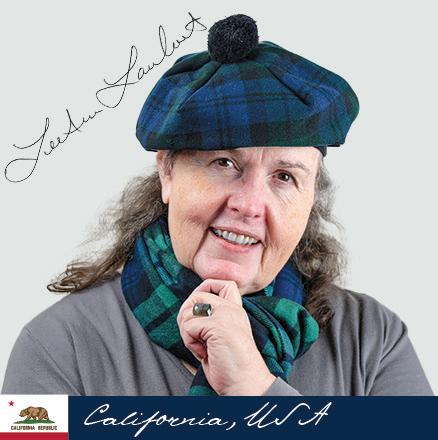





















LEADER
THE
Daravutdy Si JOURNALIST
CJ Shinihah Nortarte JOURNALIST
Winslette Quiray-Santiago JOURNALIST
LeeAnn Lambert ADVISOR
Abigail Harper MANAGING EDITOR
Bella Chimedbaatar MANAGING EDITOR Manhattan Ethington Prien EDITOR-IN-CHIEF
Sugarmaa Bataa (Kendra) ART DIRECTOR
Forrest Christensen GRAPHIC DESIGNER
Yui Leung PHOTOGRAPHER
Enkhtuvshin Chimee (TJ) PHOTOGRAPHER
Camille Jovenes PHOTOGRAPHER
Brynna Fry PHOTOGRAPHER
Bilguun Enkhbaatar PHOTOGRAPHER
Linda Laulu JOURNALIST
Mutia Parasduhita JOURNALIST
Emelia Mike JOURNALIST
Karl Aldre Marquez JOURNALIST
Myco Chillian Marcaida JOURNALIST
Emmie Siebert JOURNALIST
TEAM MEMBERS 2 KE ALAKA‘I
Ranitea Teihoarii COPY EDITOR Yichi Lu GRAPHIC DESIGNER
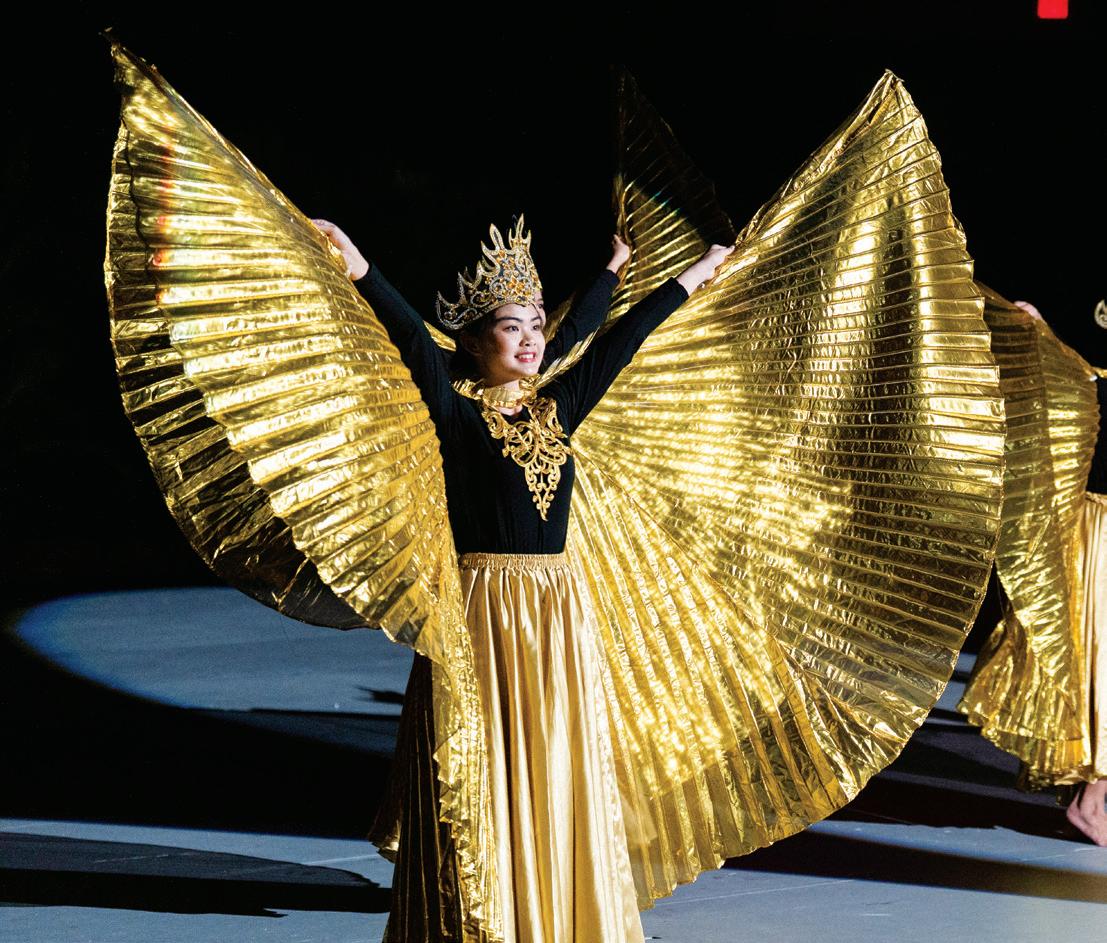
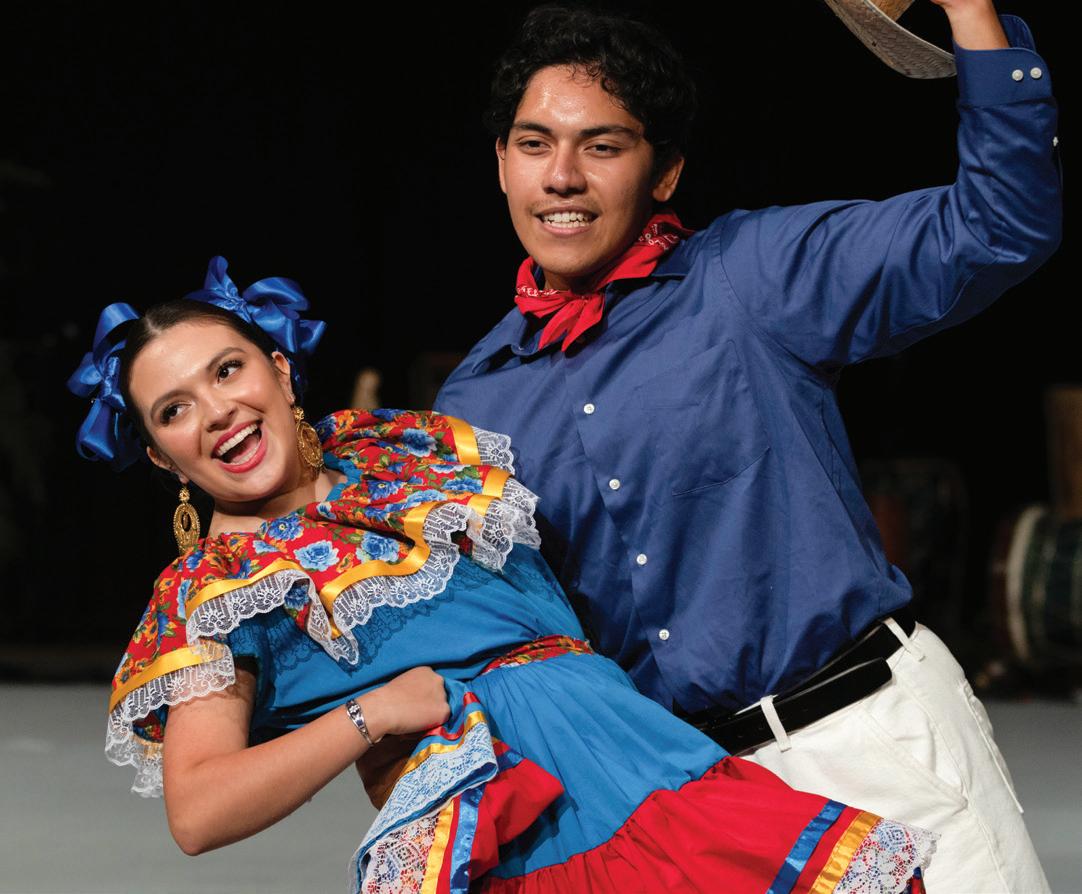
CONTENTS 6 Hawaii 8 Tonga 10 Indonesia 12 Rotuma 14 Taiwan 16 Cambodia 18 Kiribati 20 Thailand 22 Vietnam 24 Korea 26 Cook Islands 28 Aotearoa 30 Samoa 32 Latin America 34 Malaysia 36 Hong Kong 38 Japan 40 Golden Mecca 42 Papua New Guinea 44 Mongolia 46 China 48 India 50 Tahiti 52 Philippines 54 Fiji CULTURE NIGHT SPECIAL ISSUE


Don’t see your photos in this magazine? Our photographers took more! Scan the QR code to see everything we captured at Culture Night.

Do you wish you could see videos of the clubs performing at Culture Night again? Scan the QR code to watch Media Productions’ videos and share them.
NEWS CENTER: Box 1920 BYUH Laie, HI 96762
Editorial, photo submissions & distribution inquiry: kealakai@byuh.edu
To view additional articles, go to kealakai.byuh.edu

Culture Night would not be possible without the behindthe-scenes workers making it happen. Scan the QR code to read about those who were not featured on the Culture Night stage but were just as essential to the event.
CONTACT:
Email: kealakai@byuh.edu
Phone: (808) 675-3694
Office: BYU–Hawaii
Aloha Center 134
ON THE COVER AND BACK COVER: Photos of students in traditional attire from their home countries in preparation for 2024 Culture Night. Photos provided by Monique Saenz and students from her photography class. Graphics by Yichi Lu and Sugarmaa Bataa (Kendra).
PHOTOS IN THIS ISSUE: Ke Alaka’i photographers Enkhtuvshin Chimee (TJ), Bilguun Enkhbaatar, Yichi Lu, Brynna Fry and Sugarmaa Bataa (Kendra).
ABOUT
The Ke Alaka‘i began publishing the same year the University, then called Church College of Hawaii, opened. It has continued printing for more than 65 years.
The name means “the leader” in Hawaiian.What began as a monthly newsletter, evolved into a weekly newspaper, then a weekly magazine and is now a monthly news magazine with a website and a social media presence.Today, a staff of more than 25 students work to provide information for BYU–Hawaii’s campus ohana and Laie’s community.
© 2024 Ke Alaka‘i BYU–Hawaii All Rights Reserved
4 KE ALAKA‘I
Culture Night Photos Culture Night Videos Behind-the-scenes
The Ke Alaka’i staff posing in their cultural attire in front of the Cannon Activities Center where Culture Night is performed.


LETTER FROM THE ART DIRECTOR




Sugarmaa Bataa
Dear Readers,
My journey at BYU–Hawaii has been full of discovery and I have met different people and learned about different cultures, countries and opinions. The spirit of aloha and the diverse student body here made me feel at home right away. Each one of us is who we are because of our cultural backgrounds and heritage. My husband and I have helped our own Mongolian culture flourish here at BYUH by teaching our three children about it. We are constantly trying to explain to them what it means to be Mongolian by sharing our history, language, traditions, and cultures that made us who we are. However, even though we are individually striving to keep our cultures alive, we also share the single, shared culture of the gospel of Jesus Christ. We may have all been raised differently, but we are all striving for unity as children of God. We are one ohana.
This magazine celebrates how astonishing the cultures of our BYUH ohana are by sharing stories and photos from Culture Night, an annual two-night event of cultural performances. This year, 25 clubs shared dances, music, costumes and stories from their amazing cultures. Culture Night not only celebrates culture but also creates bonds between students from diverse backgrounds. At Culture Night, you can see American students performing the hula, Samoan students dancing K-pop or Chinese students sharing the haka. Here at BYUH, we share the desire to learn from and support each other. The friendships forged through the hard work of practicing for and performing in Culture Night will last forever.
You can clearly see how diverse we are just from our team page. Isn’t it awesome? Ke Alaka‘i’s wonderful team of photographers captured the event in the form of photos and video. Our dedicated team of writers painted a picture of the performances with their words. Our astounding graphic designers framed these photos and stories into beautiful layouts for you to enjoy. Of course, our strong team of editors also contributed to this multifaceted issue by providing feedback and perfecting small details along the way.
It has been a great joy for me to be part of the process, from the beginning of its preparation to its end. This 56-page magazine can’t fit the thousands of amazing photos our photographers captured during Culture Night, so don’t forget to scan the QR code on the previous page to find shots of you or your friends. We also included QR codes of a recap video of Culture Night made by BYUH’s Media Productions and a Ke Alaka‘i story about the hard work of the people behind the scenes of Culture Night. Please make sure to check those out!
Even though we all come to BYUH for a limited amount of time, the memories and relationships we create will stay with us as long as we cherish them. This magazine is to help you keep your precious memories of this incomparable event. This issue honors us all and the love and respect we have as we celebrate each other’s culture.
Sincerely,
Sugarmaa Bataa (Kendra) Art Director
SPECIAL ISSUE 5

People think hula is a grass skirt, coconut bra and waving hands, said Jade Jenkins, a junior from Kentucky majoring in business management. In reality, that is not the case, she explained. Hula makes the past feel present, she said, as it tells the story of ancestors.
Emma Kanana, the Hawaii Club service outreach specialist and a sophomore majoring in elementary education from Waianae, said the story of this year’s dance was the progression of the Hawaiian people. She said the first dance started from the beginning of the Kumulipo. “The Kumulipo is the Hawaiian creation chant that tells the order of how things in Hawaii came to be,” said Panina Matau, a senior from Laie majoring in psychology.
Following an opening prayer offered in Hawaiian, two spotlights found the men from Hawaii Club on the left side of the stage with their fists gripped and straight faces as an ancient Hawaiian chant rang through the auditorium. The men marched in straight lines to their spots, and when the drums began, they knelt facing the audience. In unison, they began to chant and create percussion with
their hands against their bodies and the floor. The force of their hands made their chests and thighs red.
The lighting then silhouetted the women as they took the stage. As the music started, the lights showed off the women’s smiling faces. Dressed in long skirts, hakus and leis, they danced a hula representing the overthrow of the Hawaiian kingdom, explained Kanana. For the final dance, the men joined the women, side by side, in black dress pants and white button-up shirts. The dancers’ eyes followed their hand movements, often meeting the eyes of the audience and their fellow performers.
Matau said she chose to perform because, “This is my time to connect back to my roots.” Although Matau grew up here, she said she did not grow up in the culture. She said her mom, who is from Hawaii, did not dance because she was always working to support her family. “I am using this Culture Night to give back,” Matau expressed. •



6 KE ALAKA‘I
Performers from Hawaii Club share the progression of the Hawaiian people through dance. Photos by Ke Alaka’i photographers. Graphics by Sugarmaa Bataa (Kendra).


Hawaii
Making the past feel present through hula
BY EMMIE SIEBERT
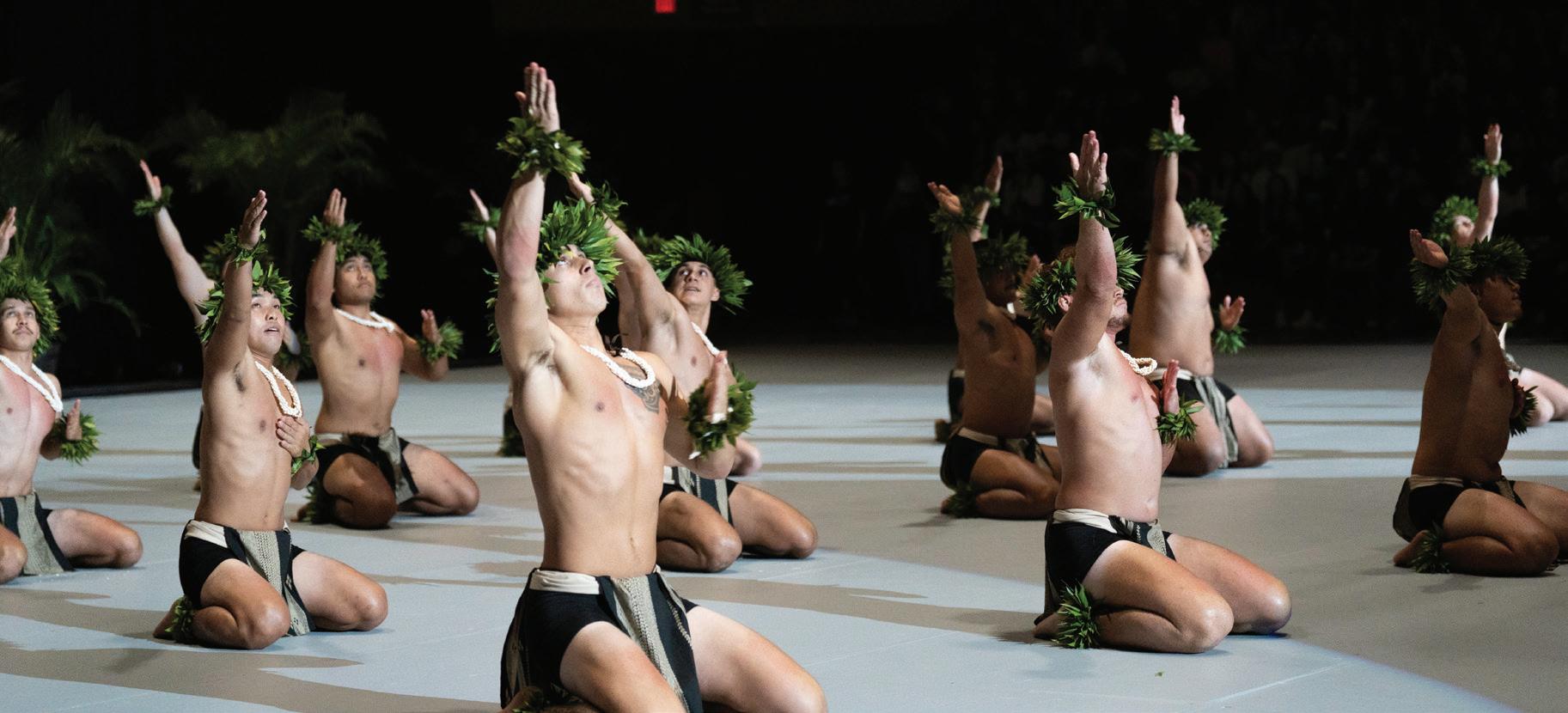
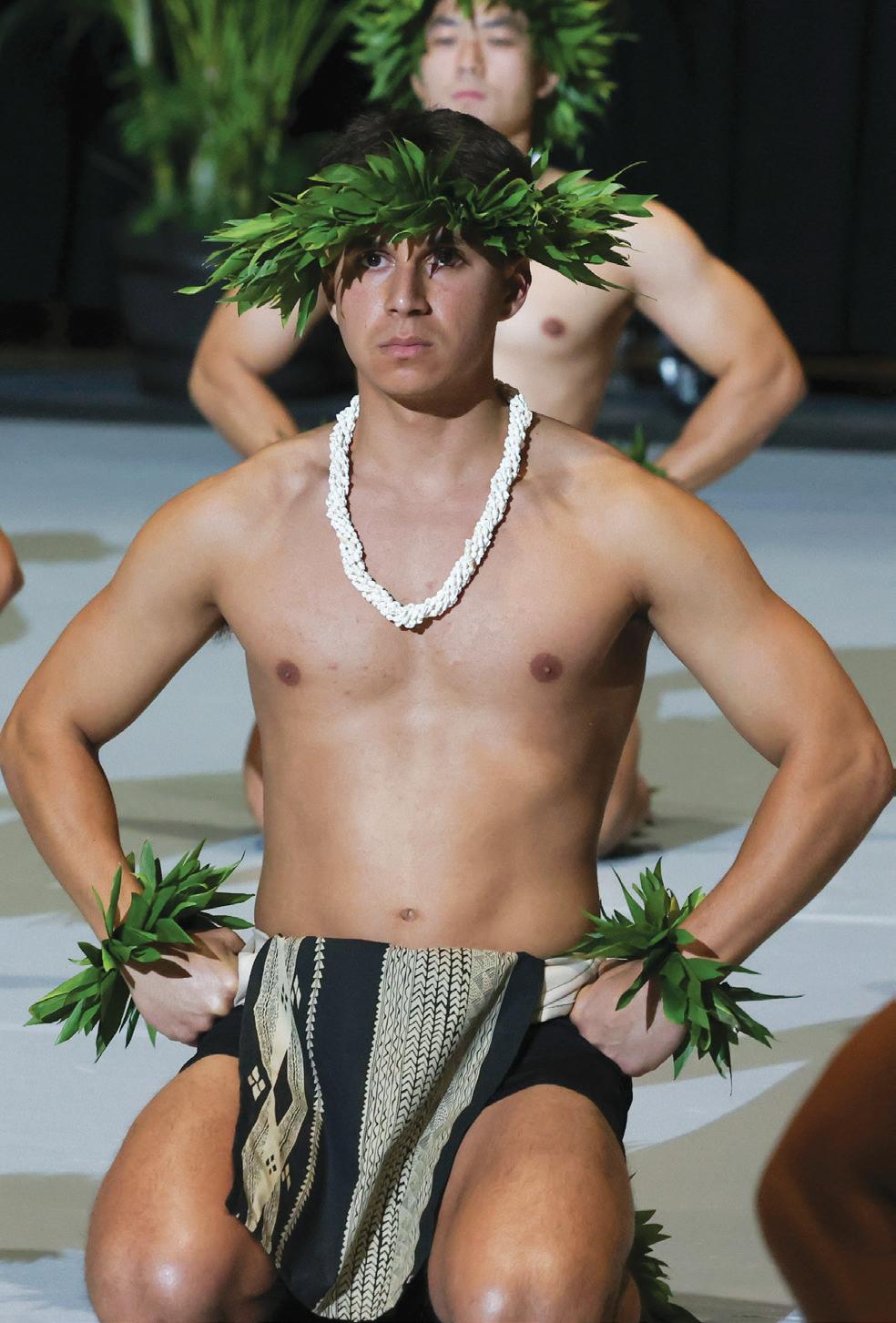

SPECIAL ISSUE 7




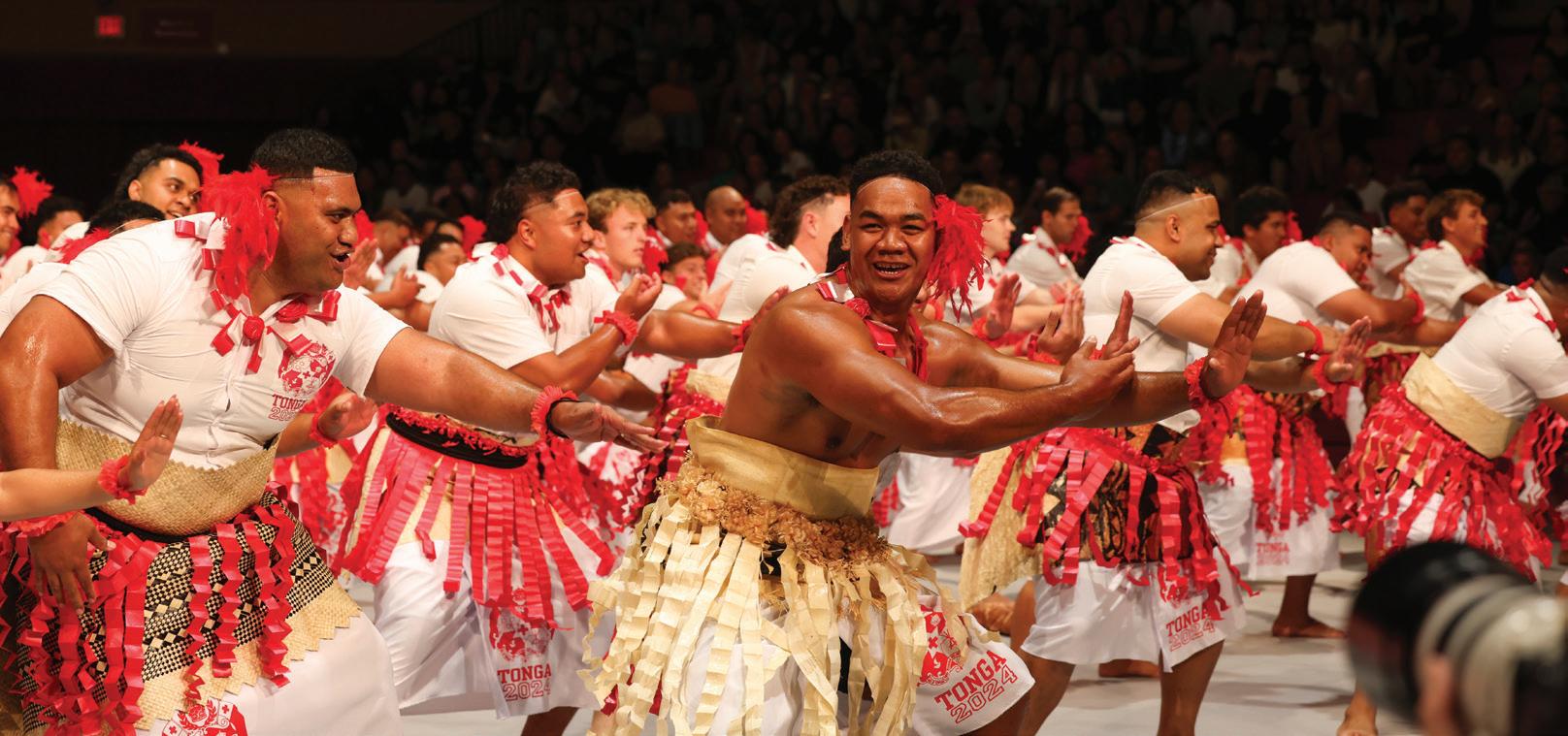
Tonga
Remembering home with strength, beauty and unity
BY CJ SHINIHAH NOTARTE
As dancers from the Tonga Club entered the stage and performed, the Cannon Activities Center echoed with cheers. In traditional attire, the women wore white dresses and the men wore white tupenus. Both of them with red kiekies wrapped around their waists.
The performance kicked off with lively movements from the men, their arms synchronized as they shared their big smiles with the audience. Following the male performers’ spirited start, the women took the stage, mirroring each other’s movements in harmony. As the performance neared its end, both men and women faced the audience and shared a song. They then danced together, accompanied by the waving of two flags representing their country in the background.
Dorothy Tonga Settle, the choreographer for the Tonga Club and a senior from Tonga majoring in biology, said the theme for Tonga Club’s Culture Night performance this year is the phrase “manatu ki api,” which means “remembering home.” She said their performance was a way of looking back at the hard work and sacrifices BYU–Hawaii students and their families have made to be here.
Albert Vaha’i, the vice president of the club in charge of service and gospel forums, said their performance features three traditional dances from Tonga called mako, tau’olunga and lakalaka. Vaha’i, a junior from Tonga majoring in business management, explained, “Mako embodies strength and courage.” Lakalaka is a dance symbolizing “loto taha” or unity, Vaha’i said. It mirrors the values of love and harmony, which are the core values of the Tongan culture, he shared.
Tuiaki He Lotu Kau, the Tonga Club’s president, said while the mako dance is only for men, the tau’olunga celebrates the purity of young women. It showcases their beauty and virtue, he said. Kau, a junior from Tonga majoring in mathematics, said the highlight of their performance was seeing people from other cultures and Tongans who hadn’t previously been exposed to their own culture learn the dances. •


Red and white filled the stage as Tonga Club members remembered their home with harmonious dancing. Photos by Ke Alaka’i photographers. Graphics by Forrest Christensen.

Indonesia
Seeing culture in the details
BY WINSLETTE QUIRAY-SANTIAGO



“Bhinneka tunggal ika,” an Indonesian phrase that means unity in diversity, is what the Indonesian Club hoped to embody through its sharp choreography at Culture Night, said Bima Kristiawan, the president of the Indonesian Club.
Choreographer Ebbygael Mocodompis shared, “Since Indonesia has many different beliefs, multiple dances and detailed hand movements were used to represent traditional worship to the gods.” She explained, “Our performance emphasizes that our differences can make us whole.”
The dancers wore black clothing with glittery gold skirts and accessories that highlighted their sharp movements and serene expressions. A lot of imagination and creativity came together for the performance, said Mocodompis, a senior majoring in hospitality and tourism management from Indonesia.
The climax of the performance was the hardest part of the choreography, she shared. It is a dynamic portrayal of a wheel moving through the sharp coordination of arm and body movements, said Mocodompis. Their months of practice were rewarded with a cheering crowd during this part of the dance.
Despite the challenging movements and fast-paced rhythm, learning the dance allowed
Shaina Pacis to better understand Indonesian culture, she said. Pacis, a senior from the Philippines majoring in hospitality and tourism management, said, “[The dance] depicted how Indonesians value camaraderie within their community.”
The Saman dance represents one of the major islands in Indonesia and is also known as “the dance of a thousand hands,” said Kristiawan, a sophomore from
Indonesia studying information technology. It is considered one of the highlights of the choreography, he said.
During this dance, the dancers started in kneeling positions and harmoniously moved up and down as they clapped their hands, tapped their chests and moved their heads from side to side. Kristiawan said, “Together we showed as much of the culture of Indonesia in a compact yet entertaining way.” •




SPECIAL ISSUE 11
Indonesia Club members don varying shades of gold as they share intricate hand movements with the crowd.
Photos by Ke Alaka’i photographers. Graphics by Yichi Lu.

Rotuma
Preserving a fading culture
BY MUTIA PARASDUHITA
Malcolm Timoteo said preparing Rotuma Club for Culture Night was one way he could raise awareness of Rotuma’s situation and preserve the hidden gem of the Pacific. He is a senior majoring in graphic design from Las Vegas but said he is connected to his Rotuma heritage.
“Rotuma is a small island part of Fiji territory, with its own culture, beautiful people and language,” he explained. A massive migration has caused the language to hit the edge of extinction, and the island has nearly been depopulated, he said. According to the statsfiji.gov.fj, the island’s population from 2007 to 2017 has decreased by 20.4 percent.
Willie Irava, a business management sophomore, is also Rotuman but grew up in Fiji. He said people move away from Rotuma because of slow development and limited higher education. However, he shared, “Some people stay in Rotuma because most people call it ‘paradise.’”
This paradise was portrayed at Culture Night with white shirts, purple floor-length skirts, ti leaves tied around the waist and red paint on the dancer’s cheeks in a reverse C-shape. The low picking of a stringed instrument and vocals started the music, but following an all-female dance, the music quickened. The audience clapped their hands and cheered as the beat picked up. The dancers ignored accidentally fallen skirts and leaves as they continued their performance for the roaring crowd.
Partway through the performance, the male dancers knelt in front of the girls and offered them the flowers from behind their own ears. A seemingly acceptable offering, the women took the flower and then the kneeling boys by the hand and danced with them.
Irava expressed how devastating it would be to lose his culture. He said by participating in Culture Night, he hopes to show that Rotuma culture is not completely extinct. “I think it is just empowering any Rotuman out there, even though we have limited resources. [Our] island is small, [but] we shouldn’t stop showcasing our region.” He said many of the club’s members are not Rotuman. “The fact they are trying to put effort into [learning] certain Rotuman dance moves shows, they are still interested” in the culture, said Irava. •





SPECIAL ISSUE 13
Rotuma Club, a newcomer to Culture Night ,showcases the dances and language of what was called the often-overlooked island of Rotuma. Photos by Ke Alaka’i photographers. Graphics by Forrest Christensen.
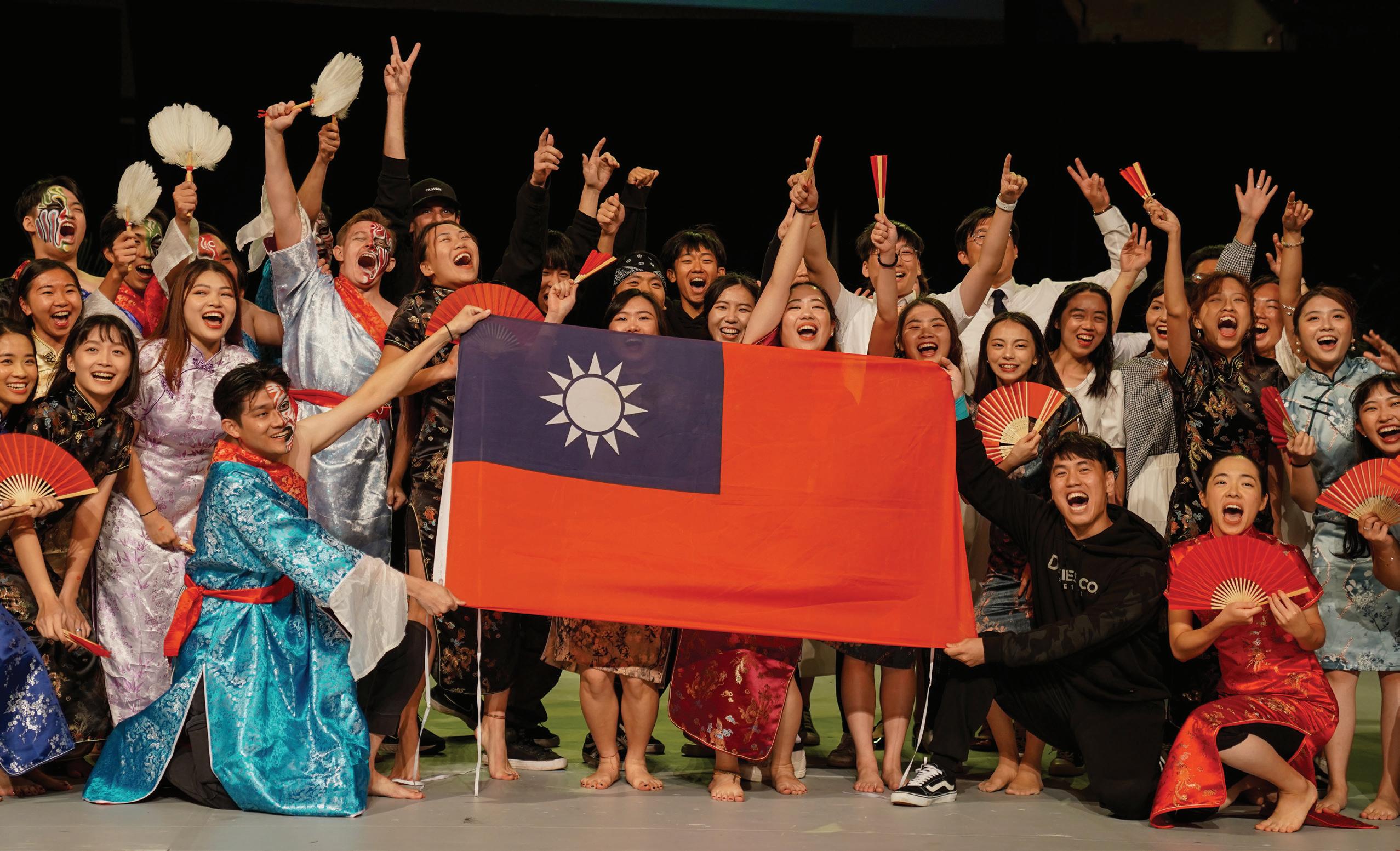
Taiwan
Modern meets traditional BY DARAVUTDY SI
Taiwanese culture was highlighted in a three-part performance at Culture Night 2024, starting with a traditional folk dance called Ba Jia Jiàng that transitioned to a modern style, said Yu Yu Wu, the president of Taiwan Club.
Wu, a sophomore majoring in marketing from Taiwan, explained Ba Jia Jiàng is generally performed at Buddhist temples and big festivals. “The dancers had to wear scary makeup and traditional costumes to scare away evil spirits,” he said. Ba Jia Jiàng is also performed before fishermen go on their fishing journeys to show respect to the gods, Wu said. During this section, the dancers sharply moved in unison white, feathered fans in one hand and sticks in the other hand.
This traditional dance quickly moved into more modern dances put together by choreographer Yu-Shan Yen. Yen, a freshman from Taiwan majoring in business management and psychology, said, “[We used] a combination of electronic dancing music and a remix of popular Taiwanese songs such as ‘Ài Ní,’ ‘Gào Bái Qì Qiú’ and ‘Hé Rì Jun Zài Lái.’”
The modern section of the performance started with performers in all-black street clothes, who danced by flinging their arms and legs outwards into rhythmic jumps and squats. Then two female dancers came out in schoolgirl uniforms to blow kisses at the street performers and started their own dance by creating hearts above their heads with their arms and beckoning the rest of the women on stage with them. The performance ended with a slow dance to “Hé Rì Jun Zài Lái,” a song about love and longing. Midway through the song, however, the sound of a scratching record needle signaled for a more upbeat version of the song to begin, during which the entire club danced along.
Yen shared, “We wanted to let people know Taiwan is special due to the combination of Japanese and Chinese culture, but we also have our original traditions.” She added, “I wanted [the audience] to know Taiwan has a lot of culture and history.” •

14 KE ALAKA‘I
Dancers in Taiwan Club dress in a myriad of costumes to convey a unique mix of modern and traditional dances.
Photos by Ke Alaka’i photographers.
Graphics by Forrest Christensen.
-





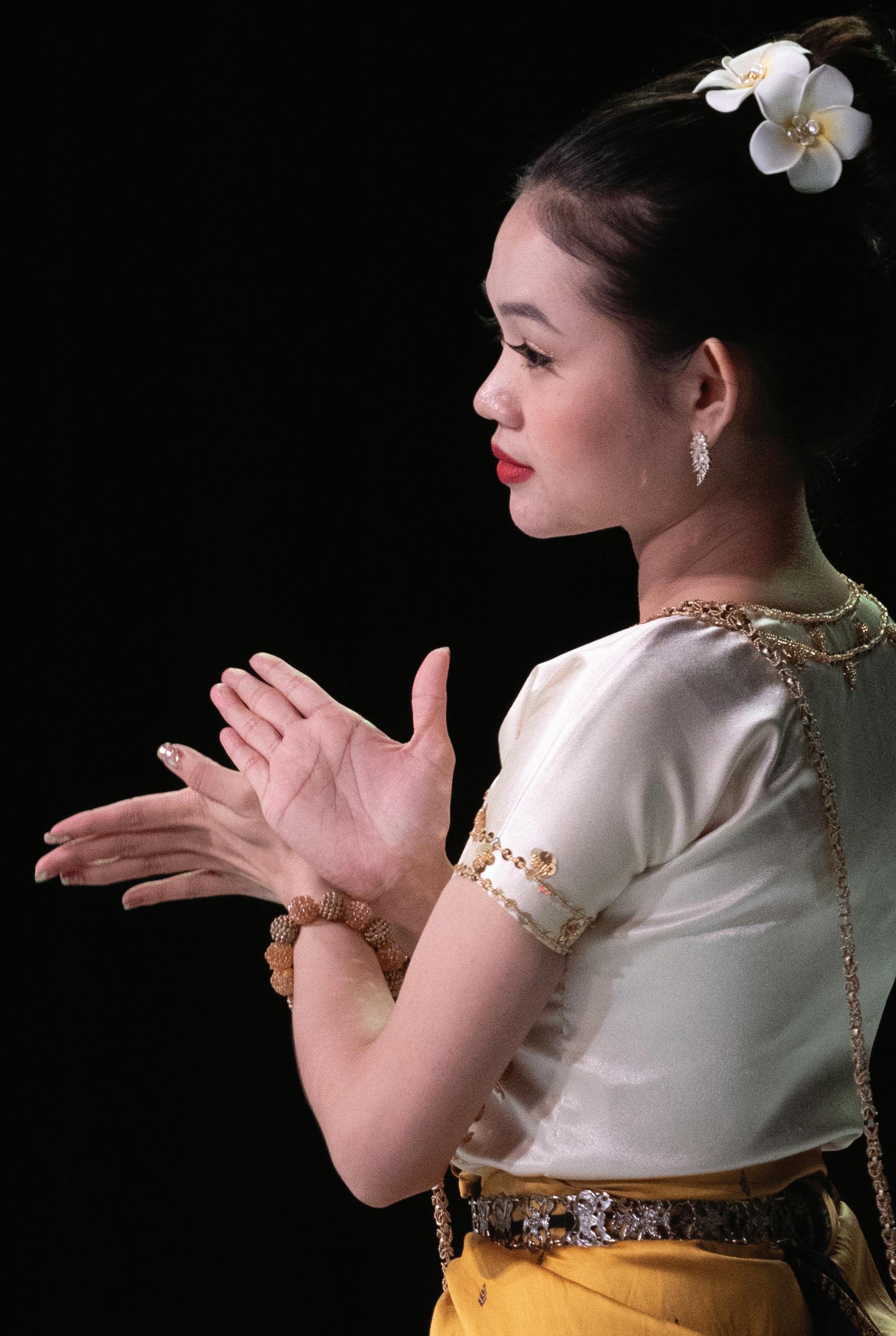

Cambodia
A different dance, a different meaning
BY LINDA LAULU
Cambodia Club members did a combination of various traditional dances to reflect their culture at this year’s Culture Night, said Vanny Sok, the Cambodia Club choreographer.
Sok, a freshman from Cambodia majoring in visual arts, explained the first dance, “Raksmey Doung Chan,” which translates to “Moonlight,” “reflected the integrity, dignity and the beauty of Cambodian women.” She shared the song emphasizes how a woman’s beauty and demeanor make her comparable to moonlight, helping to “release all kinds of
sadness and darkness in life and give [people] the courage to move on in life.”
The second dance called “Khmer” is a traditional favorite for special occasions in Cambodia that remains popular today, Sok explained. The Nam Nav dance portrayed the Khmer tribe’s narrative and highlighted their harvest gatherings, she said. The Chok Kampus dance showcased traditional food hunting techniques while the Madison dance shows the festive spirit of Cambodian communities, bringing people together in joyous celebration, Sok explained.
A rush of Cambodia Club members, dressed in purple, blue, white, gold, orange and black, crossed their legs with hands stretched out in both directions, moving to the beat as they danced onto stage. Men wore colored button-down, short-sleeved shirts, while women donned form-fitting dresses. Full sets of gold jewelry complemented their traditional Khmer clothes. Made out of a fabric called hol phamoung, the outfits included skirts called somput and kben. Their eyes tracked their hand movements as they flashed smiles to the audience.
16 KE ALAKA‘I


Cambodia Club President Hak Kim, a freshman majoring in business management from Cambodia, highlighted the dedication of the club members to the performance. “Our club size may be small, [but] our hearts are big,” he said.
Pablo Andre Gomez Robles, a freshman from Guatemala majoring in hospitality and tourism management, said, “Each step carried so much meaning and history and helped me gain insight into my [Cambodian] classmates’ perspectives.” Despite the language barrier during the practices, Robles said he enjoyed actively engaging with the club members by asking questions and showing curiosity about the Cambodian culture. •
Women in Cambodia Club poise themselves in intricate positions, and all the members gather together to dance the Madison. Photos by Ke Alaka’i photographers. Graphics
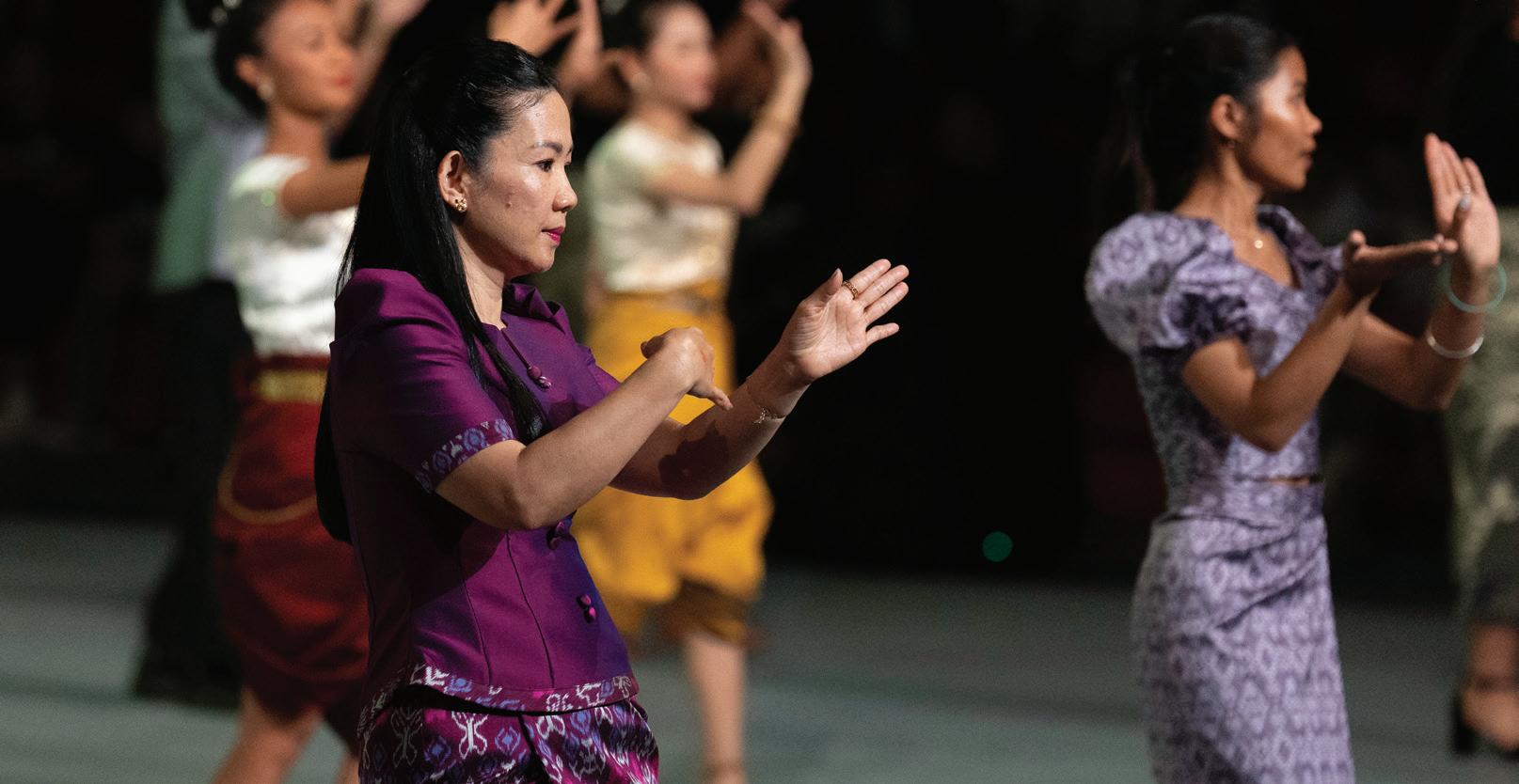


SPECIAL ISSUE 17
by Sugarmaa Bataa (Kendra).

The two parts of Kiribati Club’s Culture Night performance were meant to display the spirit and strength of the people of Kiribati, said Boata Tenite, the Kiribati Club president. He said, “Our bodies had to be strong enough the whole time to perform correctly.”
Tenite, a sophomore from Kiribati majoring in information technology, said they started the performance as they walked onto the stage with the “Mwaati,” which is a marching dance. The leader of the dance first blew a whistle and called to the performers, after which the performers began singing, stomping their feet and slapping their hands on their legs in unison. The Mwaati is performed during big parties like Independence Day, school competitions or religious events in Kiribati, Tenite explained.
The Mwaati music, “I Aki Kuba,” was sung and played live by performers while the other club members danced, said Tenite. He said the marching dance is based on the story of Moses leading the Israelites out of Egypt.
Following the first dance, about onethird of the performers used a wooden box as a drum while singing the second song. The Kiribati Club’s choreographer, Tabeta
Boraia Tangata, a sophomore from Kiribati majoring in history education, said the second dance was the “Kaimatoa,” which translates to “endurance dance.” Tangata said, “I picked the Kaimatoa because it is a combination of dances from the northern, southern and central parts of the Gilbert Island.”
Nakau Maunana, a freshman majoring in information technology from Kiribati, said, “One thing people should know about the performance of Kiribati is we dance to imitate nature, such as the waves on the ocean, the way birds fly or the way wind rustle leaves.” The performers wore two bands on each arm with dried leaves on top of them shaped to look like flowers as they thrust their arms up and out, mimicking nature.
Tangata said the hardest part about teaching the dance to club members was the hand movements. She said it is easy for the dance to be confused with other cultures if performers don’t move their hands correctly. •


Kiribati

18 KE ALAKA‘I
Club marches on the stage, using their hand and leg movements to imitate nature.
Photos by Ke Alaka’i photographers. Graphics by Forrest Christensen.


Kiribati
Strength through dance
BY DARAVUTDY SI
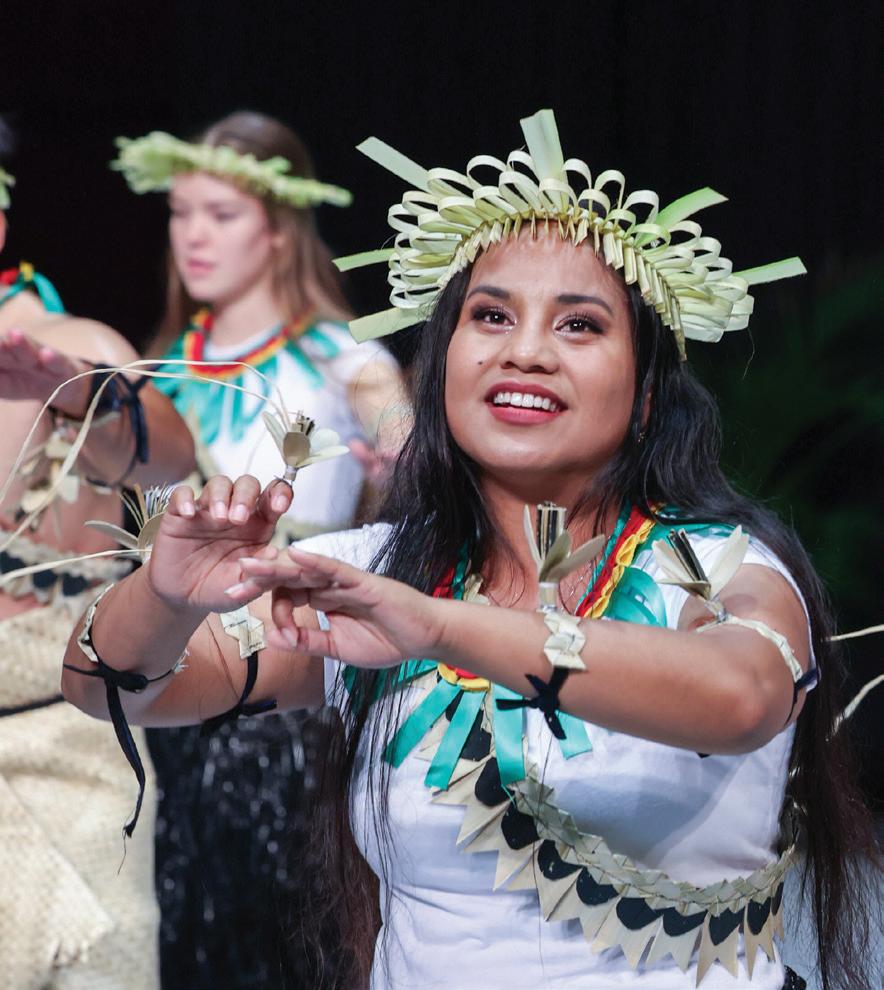



Thailand
Celebrating the Rocket Festival
BY MUTIA PARASDUHITA
Thailand’s performance started out with the slow hand movements of women in various colored tops, golden striped skirts and spikes stretching out of their buns like sunbeams. Their pointer finger and thumb came together to make a tear-drop shape with the last three fingers fanning out. The beat picked up as men walked onto the stage with instruments to catch the girls’ attention. This was a theatrical portrayal of Bun Bang Fai, or Rocket Festival, said Sawalee Saengchai, Thailand Club’s choreographer and a junior majoring in psychology from Thailand. The festival recreation got the crowd cheering and clapping in time to the shouts
of “Hey, hey hey!” from the performers and ended with the club members holding up a bamboo rocket with a painted dragon head to the cheers of the audience.
This festival is widely celebrated in Northeast Thailand where gigantic gunpowder bottle rockets are shot into the sky to communicate with the god of the rain, explained Aiyarat Buachaiya, the president of Thailand Club and a senior from Thailand majoring in communications. The catchy decorations and size of the rocket attract people as it is paraded through a city, said Saengchai. Following the parade there is food, competitions and partner dances.
She said in ancient Thailand, people believed the god of rain was very important for their rice crops. “This festival is a way to respect the god,” she said. Saengchai said not many people practice Bun Bang Fai for religious reasons anymore but the celebration has become part of the culture. •
Dancers represent Thailand Club and the Rocket Festival through bright costumes, unified dancing and a bamboo rocket,
Photos by Ke Alaka’i photographers..
Graphics by Forrest Christensen.








Vietnam
Combining past, present and future
BY KARL ALDRE MARQUEZ
“Love, past and present” was the Vietnam Club’s Culture Night theme, said Son Huynh, president of the Vietnam Club and a sophomore majoring in business management from Vietnam. He said this was the club’s third year participating in Culture Night and they performed five songs that mixed traditional music and modern TikTok trends.
Huynh said they added two songs that commemorated their country’s freedom, their resiliency from the war and their ancestors, while the remaining three focused on the future of Vietnam. He said they wanted to let the audience know that Vietnamese people are resilient and adaptable to all circumstances.
NgỌc Tieu Ly, the choreographer for the club and a sophomore from Vietnam majoring in biology, said the colors of their first
costumes, called áo tứ thân, were green and pink with matching pink and white fans the female performers fluttered in front of their faces and using sweeping arm movements. She said their costumes reflected the daily clothing women wore in ancient Northern Vietnam. The costumes were inspired by the countryside and the ups and downs of Vietnam’s history, Ly said.
During the second dance, the costumes transitioned to an all-black ensemble with a black-and-white patterned scarf the women wore around their necks and the men wore around their heads. A third of the performers in this dance hit small sticks together rhythmically while the rest of the dancers used as props the Vietnamese cone-shaped hat called nón lá. The third dance was a slower partner dance, and couples came out from the sides
of the stage dressed in pink and white. They twirled around each other until a singular man wearing black and white walked out to the middle and stopped the performance, as he beckoned for the audience to cheer louder. Then pop music began playing and the dancers smiled as they brought popular Vietnamese TikTok trends to the stage.
Gaby Cases, a senior majoring in biology from the Philippines, said the way the Vietnamese people portray their culture through dance helped her appreciate its beauty and made her feel at peace while performing with them. •
Vietnam Club members wave their flag in celebration of sharing their culture with the audience.
22 KE ALAKA‘I
Photos by Ke Alaka’i photographers. Graphics by Sugarmaa Bataa (Kendra)..





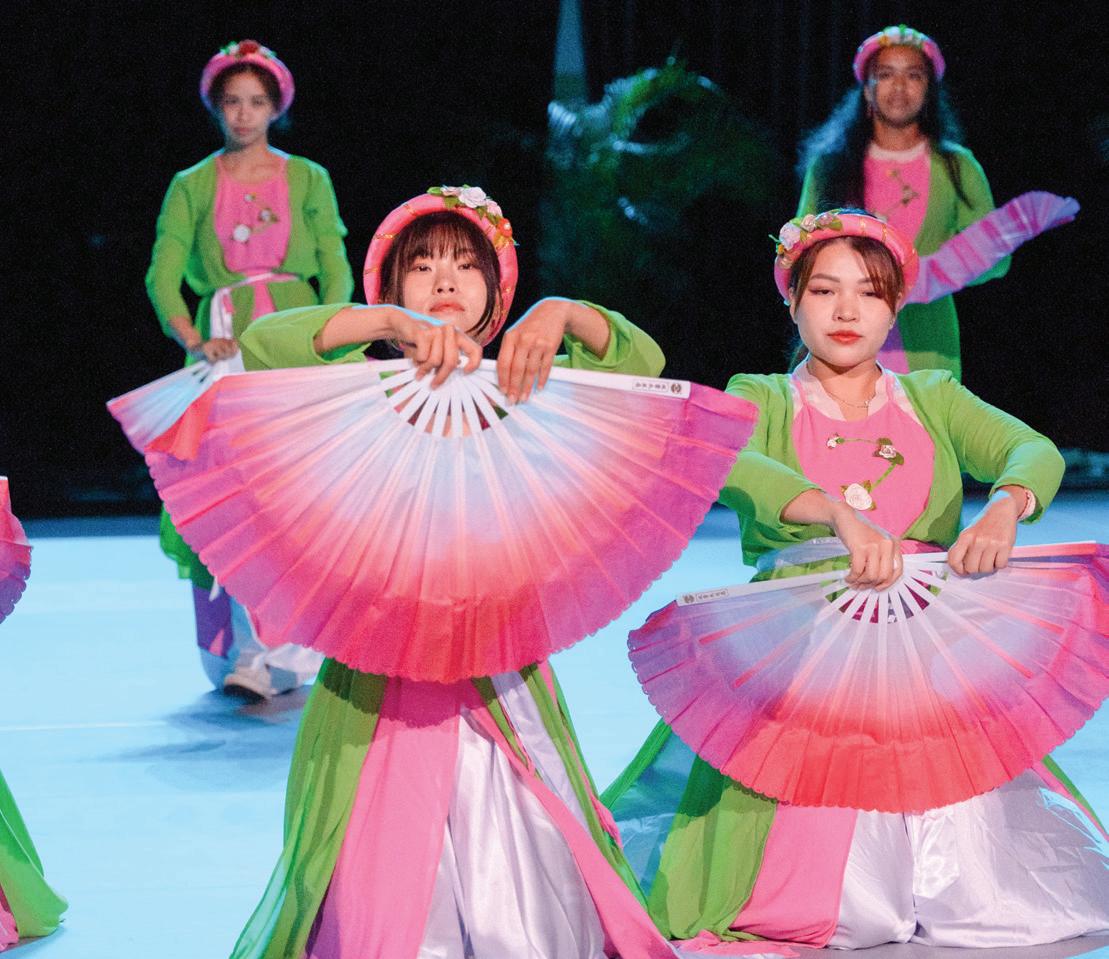
Korea
Bringing elegance and energy
BY CJ SHINIHAH NOTARTE

The Korea Club’s Culture Night performance was a combination of the traditional fan dance and three modern K-pop dances, said Minhyeok Lee, the president of Korea Club and an information technology junior from Korea. “From the graceful movement of the fan dance to the powerful energy of the K-pop dances, we hope the audiences was captivated,” he shared.
The club began its performance with a slow and flowy fan dance. Wearing their traditional attire, called “hanbok,” they moved together simultaneously, making the movement of their individual fans look like they were one fan. The fan dance is called “buchaechum,” said Hyein Wi, one of the club’s choreographers and a junior from Korea majoring in business management. She said the dancers each held two fans and connected
them to create illusions of a flower. “[The fan dance] means a lot to our culture, and one of its meanings is being one,” she explained.
Eunji Choi, a freshman from Korea majoring in computer science, said the music they used for the fan dance talks about the beauty of their country and culture. “I also loved the gentle and graceful dance movements of the dance,” she added.
The second and third parts of their dance were from famous K-pop songs titled “Super Shine” and “Pretty U.” The crowd cheered as the song’s intro began. The dancers wore pastel-colored attire and their moves made the crowd sing along with the music while they watched the Korea Club member’s unified movements.
The fourth part of the dance was also a K-pop song called “Pink Venom.” The lights
dimmed as the dancers took their places on the stage. Pink LED lights across their chest illuminated in the dark while they danced along to the beat of the song.
Wi said some people think modern dances are not part of their culture because they are not old like the traditional dances they have. But, she said, “K-pop is also part of our culture.” •
24 KE ALAKA‘I
Members of the Korea Club share Korea’s traditional fan dance and multiple K-pop dances that got the crowd cheering.
Photos by Ke Alaka’i photographers. Graphics by Forrest Christensen.






Cook Islands
Honoring ancestors and pioneers
BY KARL ALDRE MARQUEZ
Rory Pilkington, president of the Cook Islands Club, said their club focused on ancestors who have gone before in this year’s Culture Night. He said the club’s performance also commemorated pioneers who were influential in preserving the islands’ culture around the world.
“It amazes me how a small number of people from the Cook Islands on campus can create a big community and club for Culture Night,” said Pilkington, a freshman majoring in business management from Australia. He said he was impressed by the people from the Cook Islands who helped the club through their practices, music and drum beats. The drummers started off the performance with heavy beats, setting the stage for the dance’s leader to call out chants to both the audience and the performers.
Tawrie Cecil, the Cook Islands Club choreographer and a freshman from the Cook Islands majoring in psychology, said the songs in the performance talked about sailing through the waters, finding lands to live on and becoming voyagers all their lives. The dancers’ movements mimicked paddling through water and the crashing of the ocean waves to reflect this focus on voyaging. The dances they did were based on chants from the Cook Islands culture, she said.




Cecil explained their costumes, which were composed of brown and blue, represented their home country and ancestors. The women wore hip bands and headdresses made of dry leaves and necklaces and armbands made from shells. The men also wore accessories made from dried leaves, including leg bands and thick, triangular lei-shaped necklaces.
Gina Escalante, a senior majoring in psychology and social work from Peru, said watching the club perform at the previous Culture Night made her want to join them this year. She said the Cook Islands dances had beautiful and graceful steps that relate to deeper stories and symbolism. Some dance steps reminded her of her own culture, she shared, which made her feel loved and connected to the Cook Islands. •
energetic movements reminiscent of voyaging, dancers represented their ancestors and the culture of

 Through
the Cook Islands.
Photos by Ke Alaka’i photographers.
Graphics by Sugarmaa Bataa (Kendra).
Through
the Cook Islands.
Photos by Ke Alaka’i photographers.
Graphics by Sugarmaa Bataa (Kendra).

Aotearoa
Remembering Christ through song
BY WINSLETTE QUIRAY-SANTIAGO
The Aotearoa Club combined a chorale, synchronized poi dancing and the traditional haka dance in its performance. The Aotearoa Club members said they hoped the audience felt empowered during their performance at Culture Night.
Starting the performance with a harmony of blended voices, their entrance song was called “Whakaeke,” which means “going onto,” said Darian Settle, the performer in charge of leading the chorale.
Hearing the song at practice and knowing its deep meaning encouraged Sophia Rolie, a junior from Oregon majoring in political science and intercultural peacebuilding, to perform with the Aotearoa Club. She said, “There is a part in the song where it tells us to go after our dreams, accomplish what we want
and become something, but always remember to bow your head to the mountain,” said Rolie. “The mountain represents Jesus Christ. It is an empowering song but is also a humbling song,” she added. “It was a spiritual experience.”
The Aotearoa Club President Maui Kinikini, a sophomore majoring in psychology from New Zealand, said most of the club’s previous performances were predictable but this one is different. “We can all connect to the song by thinking that each of us has challenges to face and to climb,” he said.
Settle, a sophomore majoring in social work from New Zealand, said some club members were challenged during the practice because, “It is not only a test of their coordination and singing. There are other factors as well.” One of these factors is to have
the right facial expressions while performing, Settle said. “There are more expressions than just smiling,” he explained. “We have to learn to show the right expression to be able to get the message across.”
The dancers shared these varying expressions during the loud chants of the haka as they stomped their feet, bared their teeth and kept their wide-eyed stares focused on the audience. •
The Aotearoa Club members swing poi balls and perform the haka for a cheering audience.
Photos by Ke Alaka’i photographers.
Graphics by Yichi Lu.
28 KE ALAKA‘I

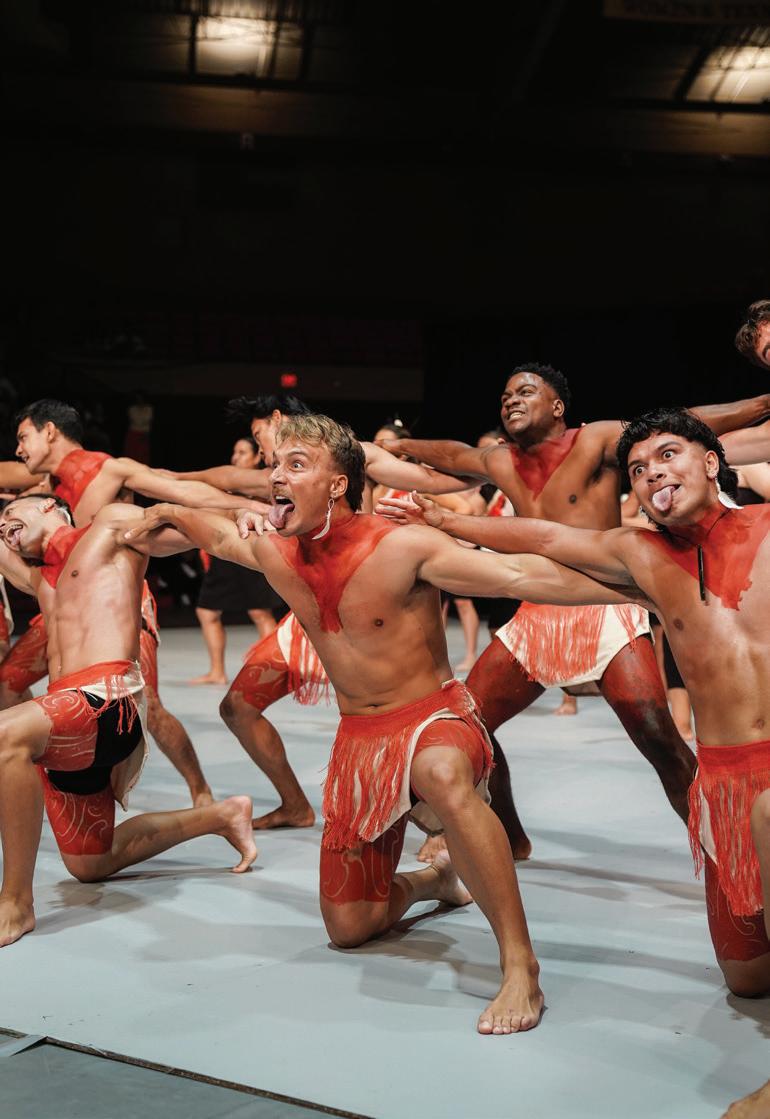


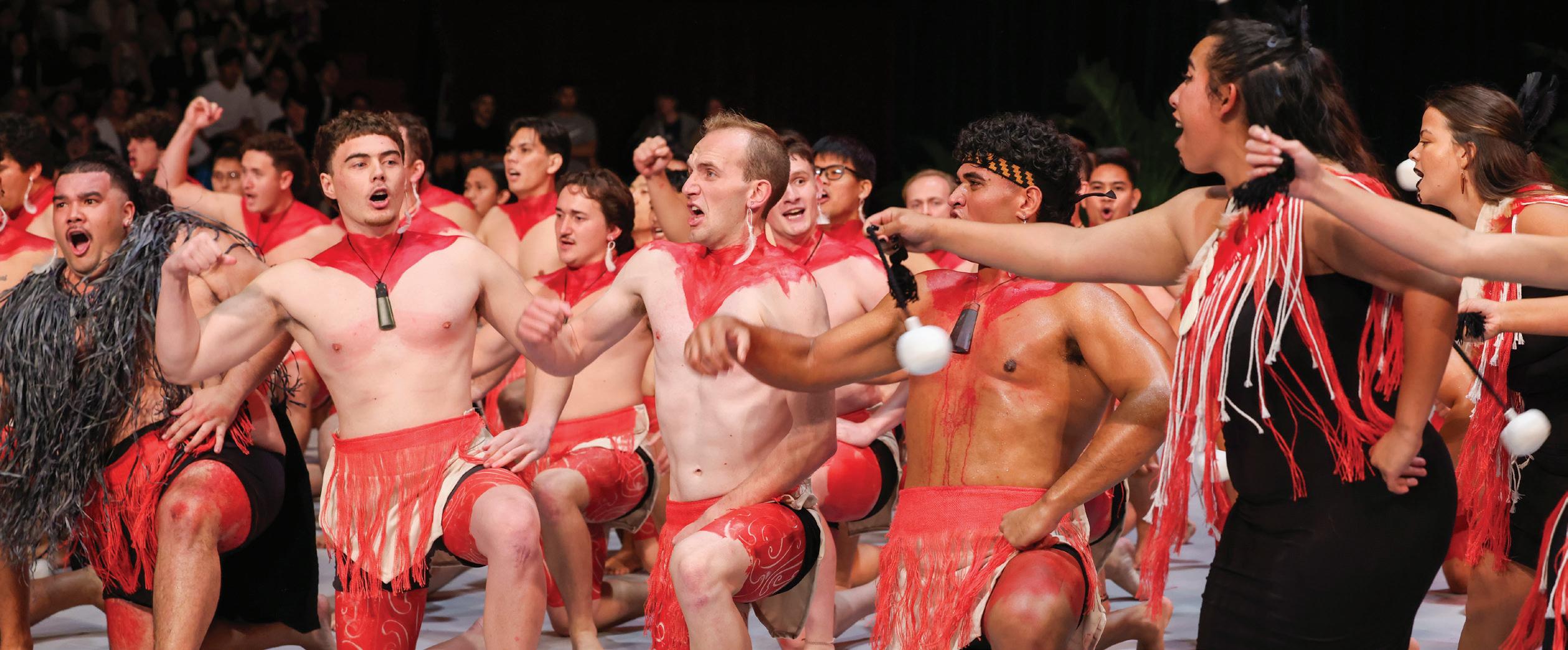
Samoa
Dancing for culture and a cause
BY MYCO MARCAIDA

Wearing red dresses and yellow feather boas in their hair, lava-lavas and ti leaves spray painted with yellow and red, and red marks painted on their cheeks, the Samoa Club was ready to perform.
The club’s members lined up on stage in their intricate costumes, but before the club’s performance started, Norman Uili, a sophomore majoring in information technology from Samoa, said the club was dedicating its performance to raise awareness for and support those who fight mental health “battles every day.”
The Samoa Club’s yearly performance was composed of the sasa, ma’ulu’ulu, fa’ataupati and a taualuga, said Linda Laulu, a junior from American Samoa majoring in elementary education.
According to Laulu, the first dance, the sasa, is a traditional dance with men and women that starts from sitting down, demonstrating different motions that represent the daily chores in the islands.
The second dance, the ma’ulu’ulu, is usually performed to celebrate important occasions, honor guests and tell stories from Samoan mythology and history, she said. Laulu explained the song for this year’s ma’ulu’ulu, called “Lalelei tofaina oe,” by Annie Graceis, is a farewell to a woman who is compared to a rose no one can resist.






The fa’ataupati, which was the third dance, is a rhythmic dance where performers create percussive beats by slapping their thighs, chest and arms, Laulu explained. “This dance is often performed by men, showcasing their strength, coordination, and skill,” she said.
Laulu shared the taualuga danced at the end of the club’s performance is performed by a male or female and is traditionally danced by a high chief’s daughter or son. This dancer usually has a traditional crown on their head, and their intricate movements are accompanied by rhythmic singing.
The Samoa Club President Alexander Galea’i, a junior from Laie majoring in business management, said he saw Samoan culture celebrated by club members as they gathered and participated in activities this semester.


Logan Williams, a junior majoring in elementary education from New Zealand, shared, “Being here at BYU–Hawaii and immersing myself through Culture Night alongside a supportive community allows me to stay true to my roots.” •
Performers from the Samoa Club smile while sharing their cultural pride and dancing to raise awareness for mental health.
Photos by Ke Alaka’i photographers..
Graphics by Yichi Lu.
SPECIAL ISSUE 31
Latin America
Bursting with colorful energy
BY WINSLETTE QUIRAY-SANTIAGO

The sounds of heels clicking on the floor and chants of excitement intermingled with blaring trumpets was heard as the Latin America Club shared its colorful performance at Culture Night.
The performers had smiles on their faces as they represented various dances from countries throughout Latin America.
The Latin America Club President Alan Pineda, a sophomore from Mexico majoring in communication, media and culture, said, “Often we are portrayed as energetic people.” He said they wanted to depict that energy through every aspect of their performance especially through the sounds of musical instruments, like the trumpet and concordia, mixed with the shouts of the dancers.
Isabel Becerra, a senior from Utah majoring in English, said a lot of Latin dancing depicts closeness and friendship. “Another big part of Latin American dancing is enthusiasm,”


32 KE ALAKA‘I
she explained. “This is a culture that is very passionate, exciting and expressive.”
Caleb Maxey, one of the Latin America Club choreographers and a sophomore from Illinois majoring in psychology, said they had to split into groups to represent just a fraction of all Latin American countries.
One of the dances they shared is called “El Toro Mambo.” It is a dance where men use leg movements to convey the strength of bullfighting, Maxey shared. “Bullfighting has been a big part of the traditional culture in Mexico. It is an entertainment that families pass on,” he said.
In the same dance, women swirled their different colored dresses and wore matching colored ribbons in their hair. The Latin America Club members exuded a unique energy, said Maxey, as they danced with the upbeat music. Maxey said, “No matter what dance you watched, you ought to experience that high energy. That energy will always be there.” •


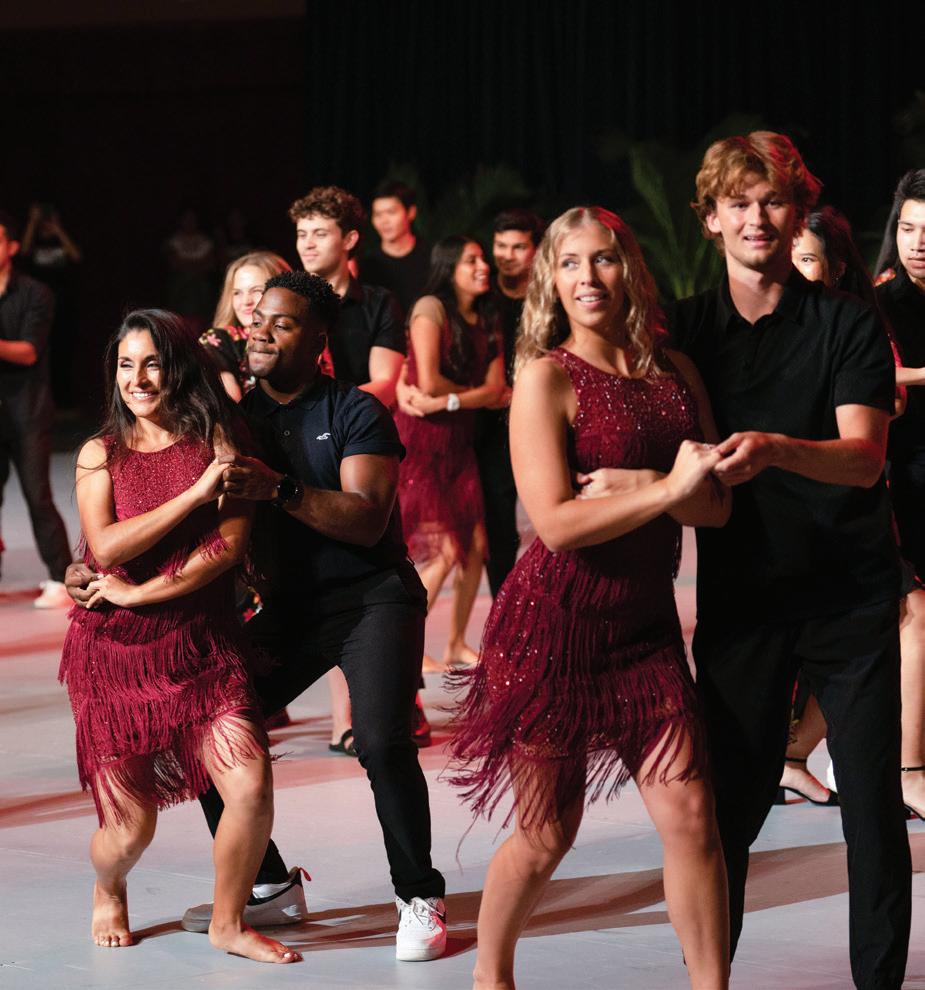

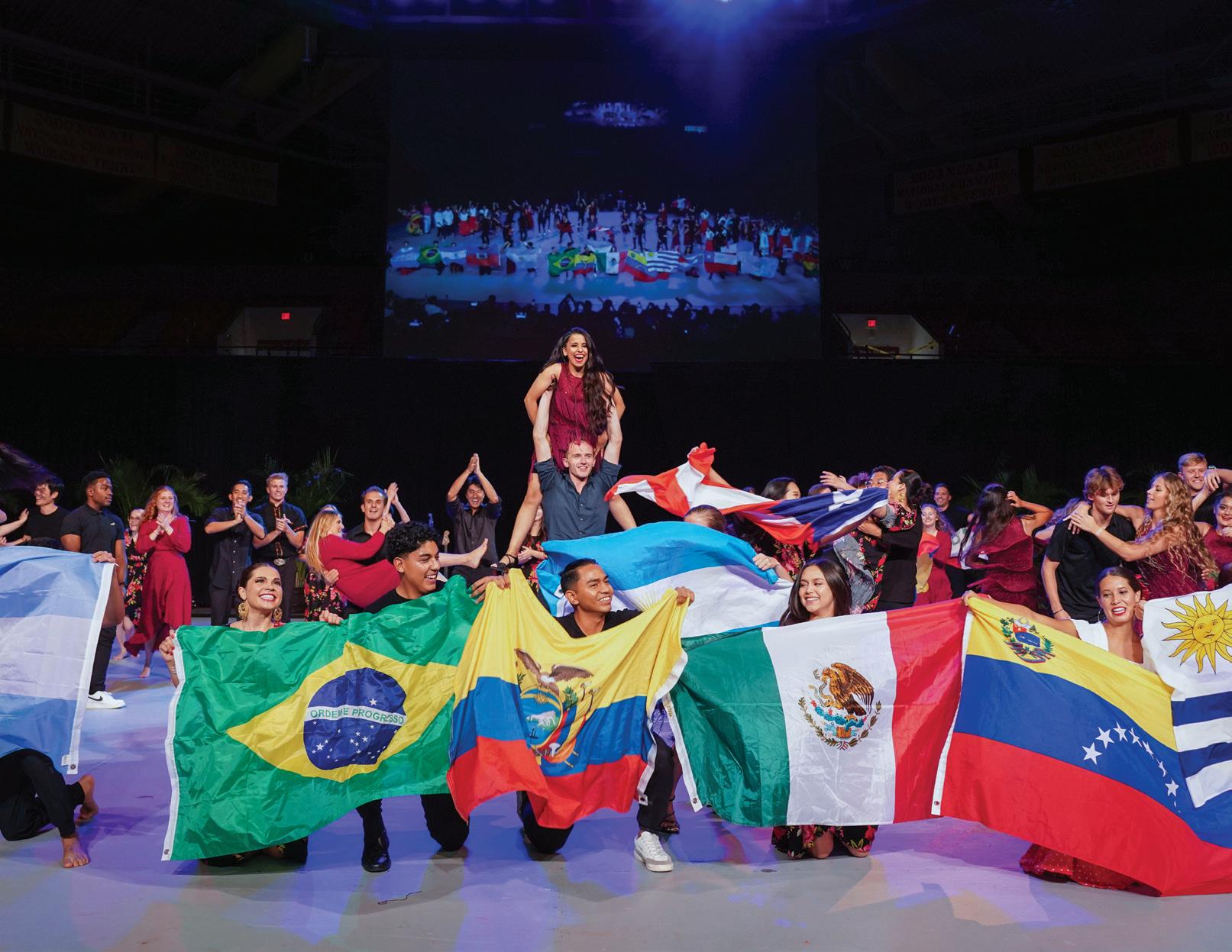 The Latin America Club represents various Latin America countries through colorful costumes, dances and songs. Photos by Ke Alaka’i photographers. Graphics by Yichi Lu.
The Latin America Club represents various Latin America countries through colorful costumes, dances and songs. Photos by Ke Alaka’i photographers. Graphics by Yichi Lu.
Malaysia
Retelling a traditional story
BY DARAVUTDY SI






The Malaysia Club told a story from West Malaysia about Sultan Mahmud of Malacca, a man who wants to marry a beautiful celestial princess on Mountain Ledang, in this year’s Culture Night performance, said the Malaysia Club President Emelia Mike.
Mike, a senior from Malaysia majoring in communication, media and culture, said she picked this story because it teaches people integrity. She said integrity is crucial as it forms a foundation of trust and reliability by being honest and consistent.
The performance started with a dance from the princess and her subjects. Captivated by the princess’ beauty, the sultan then sent his warriors to deliver his proposal. The princess fought off the warriors using the defensive kicks, punches, and strikes of the Malaysian
silat, which is a traditional form of martial arts, said Ajay Tamilarason, the Malaysia Club choreographer and a freshman from Malaysia majoring in health and human sciences.
Before accepting the sultan’s proposal, the princess pulled out a yellow scroll bearing seven tasks for the sultan to complete and threw it toward the warriors. The princess’ face was stern throughout the rest of the performance as she led her subjects in the finale of the dance.
This year’s costume was inspired by a 2004 Malaysian fantasy film called, “Puteri Gunung Ledang,” Mike said. She said the costumes varied from character to character. The Sultan wore a royal headdress and Malaysian traditional outfit, called Baju Melayu and Samping, and the princess wore a crown called Cucuk Sanggul and batik-inspired pants instead of a skirt for easier movement.

Mike expressed difficulties in finding authentic traditional wear. She shared she had to combine items found in the club storeroom with some online purchases to achieve a look that reflects West Malaysian culture as closely as possible.
After joining the Malaysia Club, Abraham Vanimi, a sophomore from India majoring in information technology, said, “I am interested in learning about their culture, and I wanted to perform for them.” Vanimi added, “The Malaysia Club is so diverse, and they treat me like I am their family by making me feel included in every activity they have.” •
A celestial princess, her subjects, a sultan and his warriors all dance on stage in the Malaysia Club’s performance.
Photos by Ke Alaka’i photographers.
Graphics by Forrest Christensen.
SPECIAL ISSUE 35
Hong Kong
Traveling in search of a dragon
BY MYCO MARCAIDA
Dallin McKinney, a senior from California majoring in music and TESOL, narrated his journey around Hong Kong in search of the Chinese dragon on a screen behind the Hong Kong Club performers, pausing to let the dancers depict the different spots on his journey.
Chak Yin Kong, the Hong Kong Club choreographer and a senior majoring in TESOL from Hong Kong, said the dragon dance is performed every year, but this year they decided to add certain colors and other dance elements for their Culture Night performance. At the last stop of McKinney’s journey, Taipo Market, cheers were heard across the Cannon Activities Center when a lit-up Chinese dragon entered the stage. The green body of the dragon with its hints of yellow moved swiftly, illuminating the darkened auditorium. Kong said the dragon dance symbolizes heroism, bravery and courage. “The dragon dance involves 11 people and heavily relies on teamwork and collaboration for it to be successful,” he shared.








On Yu Kwok, the club’s vice president and a sophomore from Hong Kong majoring in social work, said she appreciated members of the club coming together for practices and gathering for other club events. Kwok said the club’s efforts showed unity despite cultural differences.
Kong said the club’s main goal at Culture Night was to showcase modernism in Hong Kong culture. She explained, “We wanted to show different aspects of modernism including a variety of costumes with warm and muted colors for the first and second dance.” Dominant colors of pink and blue were worn for the first dance, which was performed by an all-female group and took place at Causeway Bay. During the second stop at Mong Kok, the mix of male and female performers wore mainly black and white street clothing. •
The Hong Kong Club dancers dressed in a variety of costumes to represent Dallin McKinney’s different stops on his way to find the Chinese dragon.
Photos by Ke Alaka’i photographers..
Graphics by Yichi Lu.
SPECIAL ISSUE 37
Japan
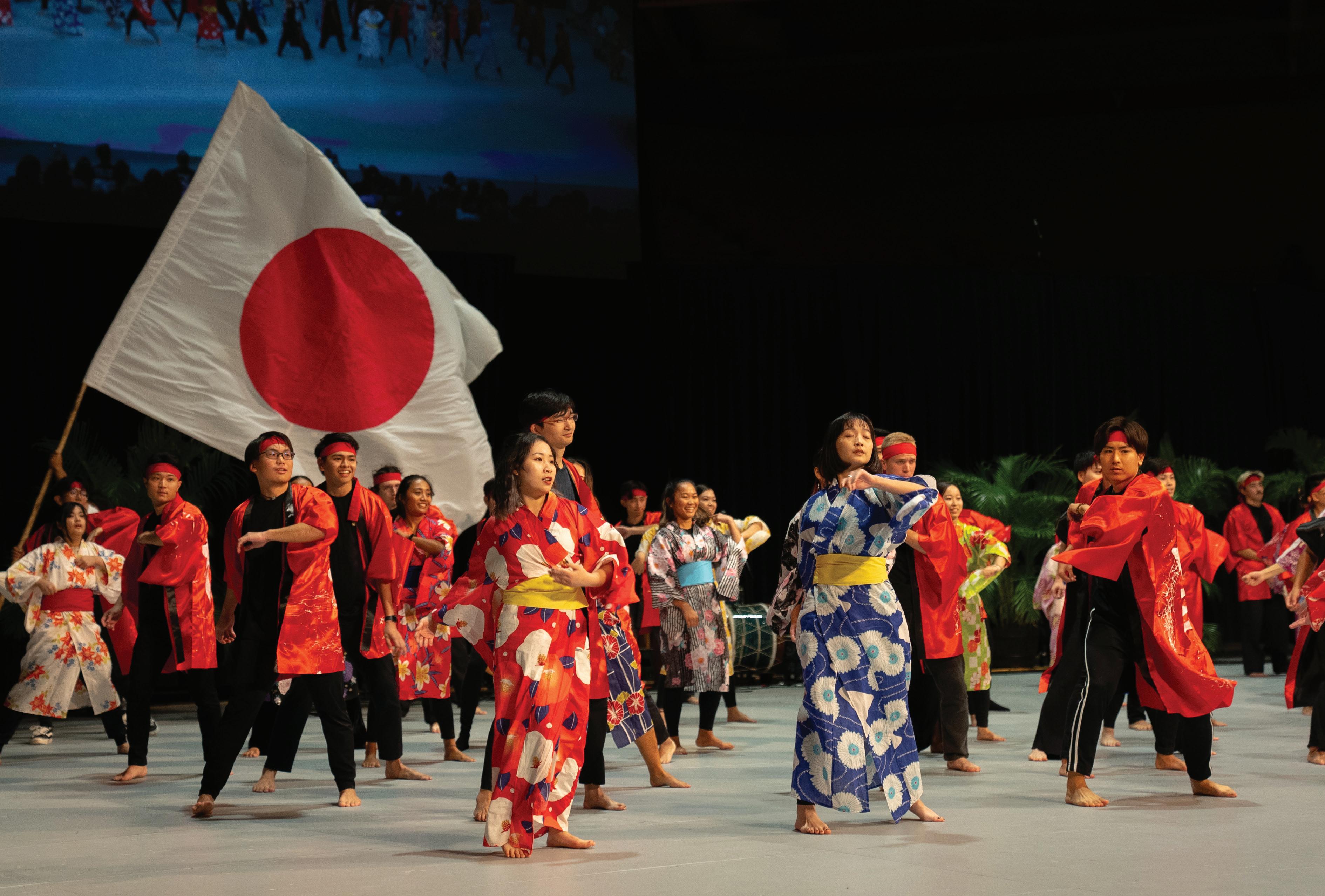
An explosive invitation to celebrate
BY CJ SHINIHAH NOTARTE
Colored lights streaked through the air, leaving a bright trail of light against the dark as dancers from the Japan Club began the first part of their performance. Each member held one light in each hand while dancing, creating moving light beams on stage of light. In the second part of their dance, anime characters such as Naruto and Sakura took the stage with other dancers, eliciting loud cheers from the crowd.
During the last part of the club’s performance, the spotlight was on seven dancers who were wearing kimonos and holding umbrellas. In the first few seconds of the music, they swung their umbrellas around as they swayed and turned before other dancers ran to the middle of the dance floor. The lights shone down on them and the music turned up. They all danced with big
movements, jumping, turning and using their arms to accentuate their moves.
Yohei Minegishi, the president of the Japan Club and a junior from Japan majoring in social work, said their Culture Night performance consisted of three dances, with a combination of modern dance, traditional dance and anime culture.
Eimeo Lee Chip Sao, a club member and a sophomore from Tahiti majoring in hospitality and tourism management, said the Japan Club’s dances were fun to perform because they were explosive. They had lots of big movements and he enjoyed dancing together with fellow students, he shared.
One of the traditional dances the Japan Club members performed was from Reika Iwano’s home city, Shizuoka Prefecture, she said. Iwano, the Japan Club’s choreographer
and a junior from Japan majoring in elementary education, said the dance is called “yosakoi,” which means “Come to the festival tonight.” She said their dance symbolized inviting the attendees of Culture Night to come to the festival and celebrate with them.
“I am really grateful for the performers,” said Iwano. She said they were enthusiastic, understanding and patient. “I want them to know how much I love them and how much I am grateful for them,” she shared. Minegishi added, “We hope everyone enjoyed our performance as much as we enjoyed preparing for it.” •
Performers in the Japan Club use umbrellas, lights and costumes to convey a modern dance, a traditional dance and an anime-inspired dance.
Photos by Ke Alaka’i photographers. Graphics by Forrest Christensen.
38 KE ALAKA‘I

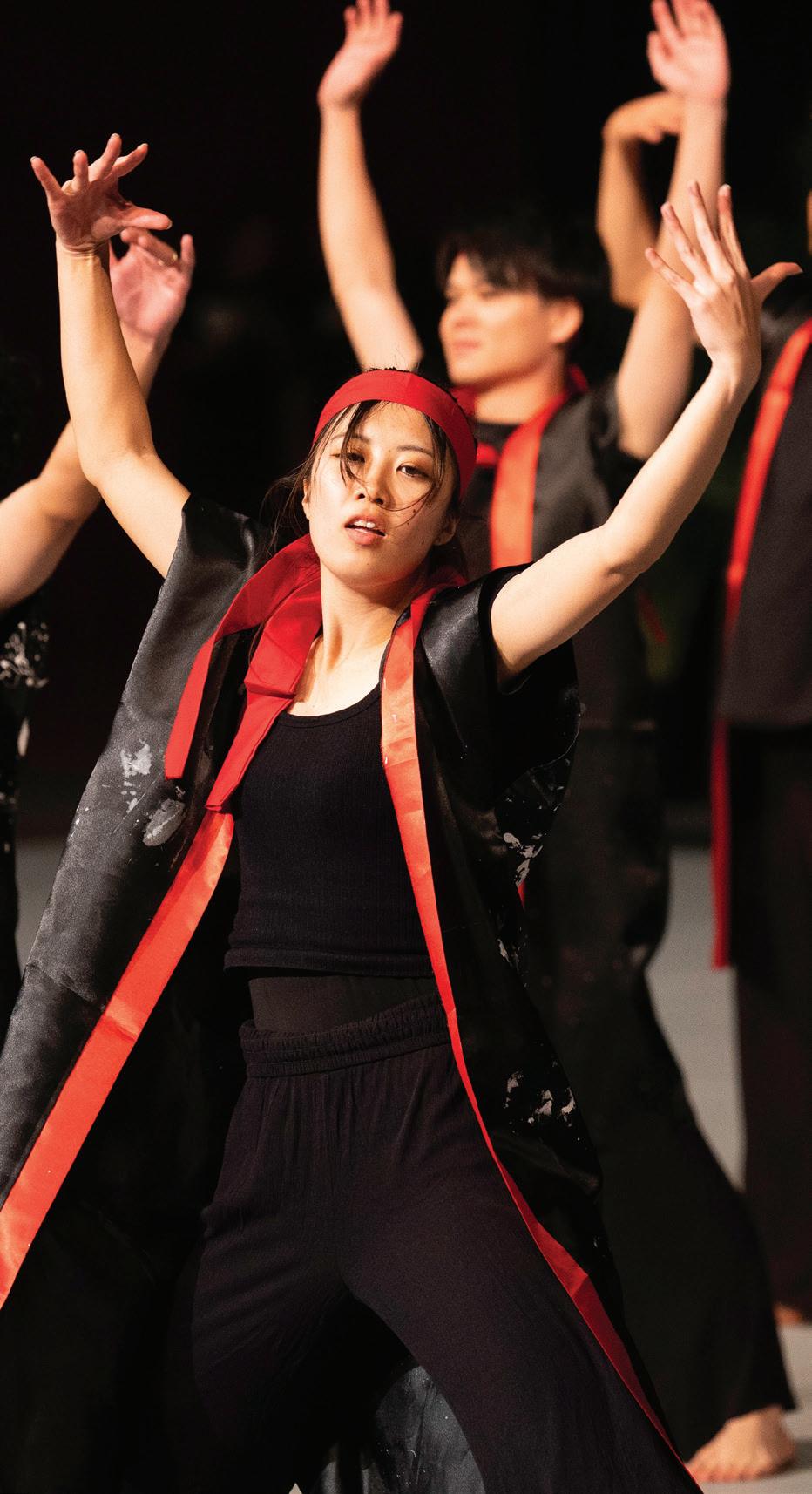




Golden Mecca
Rewriting the narrative of the Middle East
BY EMELIA MIKE
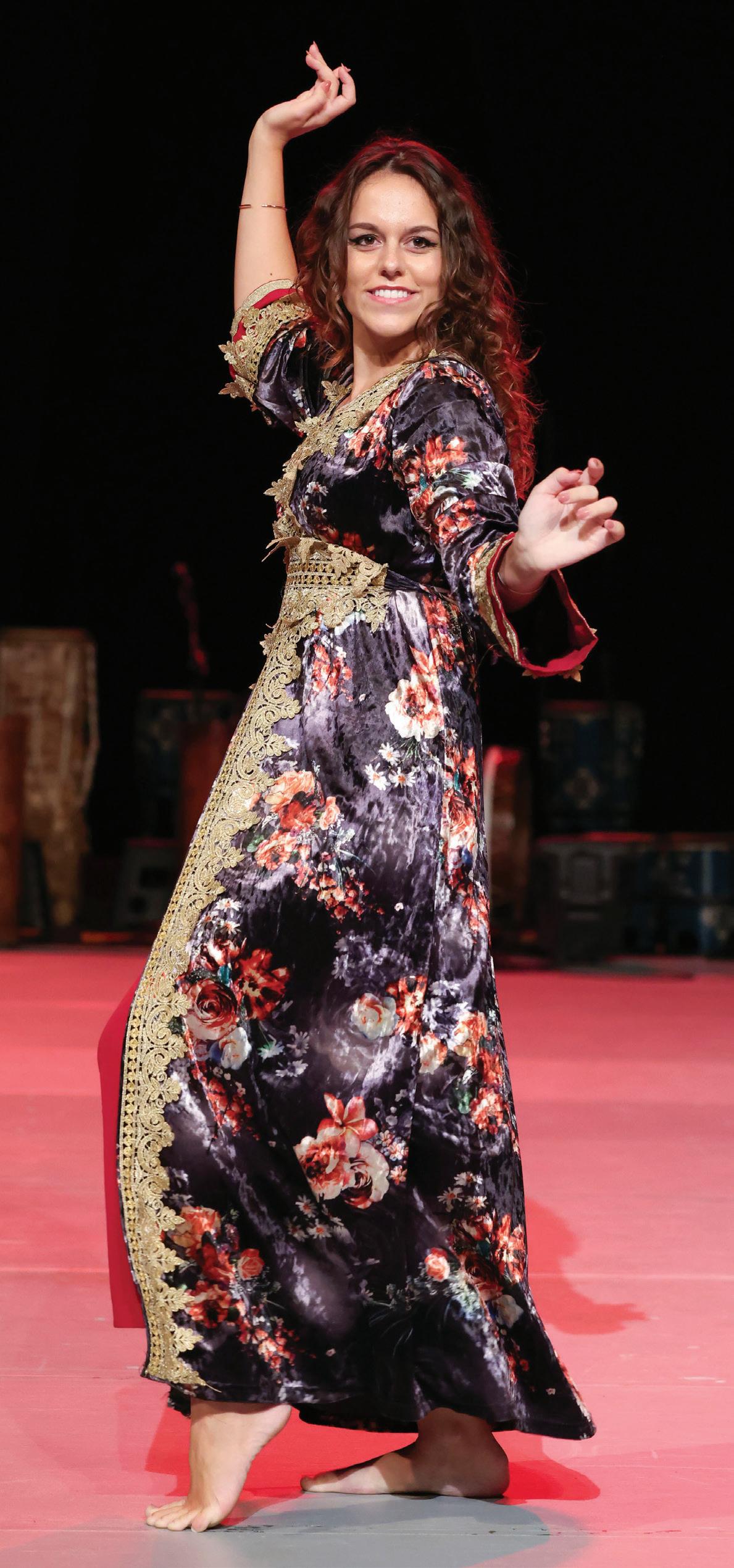



The Golden Mecca Club, a club celebrating the Middle Eastern cultures of Egypt, Afghanistan and Iran, also known as Persia, performed in its first Culture Night this year. The goal of the club was to share knowledge, promote peace and introduce others to the beauty of the Middle East, said the Golden Mecca Club President Elisabeth Jaleh Younessian, an anthropology and cultural sustainability senior from California.
People often have misconceptions about Middle Eastern cultures due to the media and politics, said Zoe Vealey, a junior majoring in TESOL from Utah. The club’s choreographer, Alexa Milad Utahia, a senior majoring in intercultural peacebuilding from Canada with Egyptian heritage, said their theme was “unity in diversity.” She wanted to represent the unique characteristics of Persian, Afghan and Egyptian cultures while emphasizing their interconnectedness.
All of the dances contained different iterations of accentuated hip-pops, smooth arm movements and skirt swishes. Utahia said, “We split our choreography into three sections for the three cultures so that we could be as authentic as possible in sharing the cultures, music and movements we grew up with.”
Younessian said she hoped the audiences saw glimpses of Iran’s romance, Egypt’s royal tradition and the celebration of Afghanistan. “In the end, we shared a collective dance, and hoped the audience felt a sense of realization, recognition and respect for the beauty of the Middle East,” Younessian said. To capture the joy of the Middle East, she said, the last number was performed with smiles, head tilts to the beat and inviting arm gestures toward the audience. The performance culminated in dancers waving flags from various Middle Eastern countries, representing the vast cultural diversity in the Middle East. •

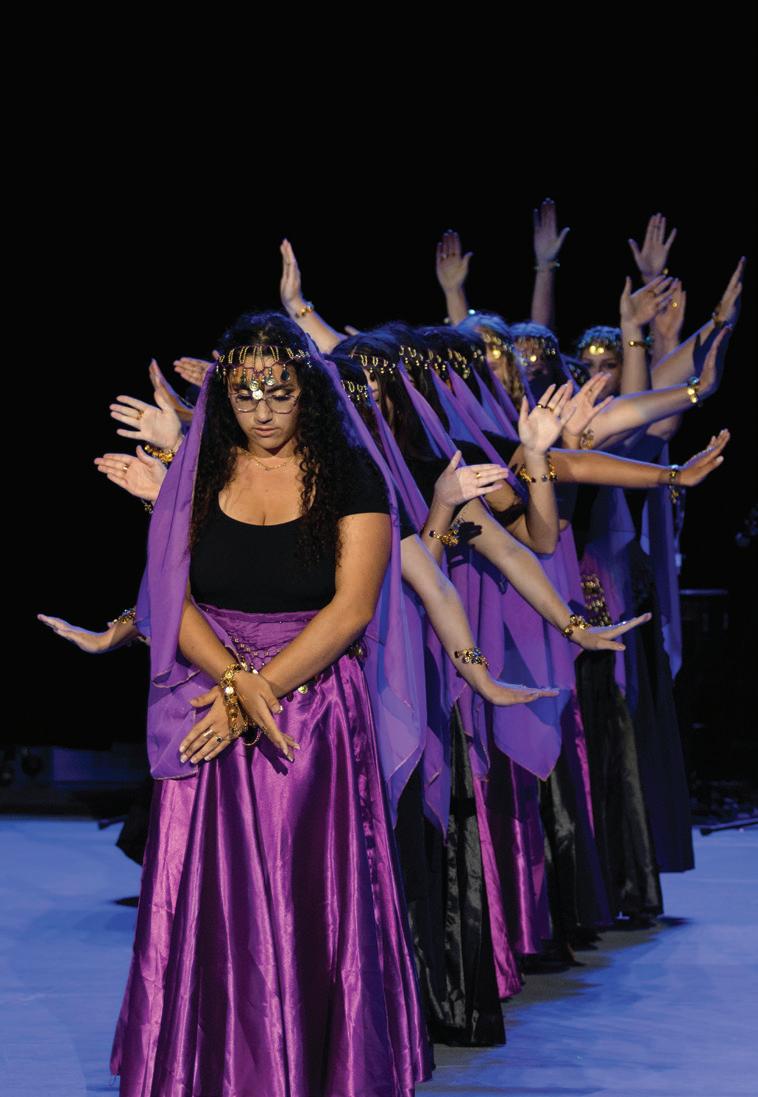
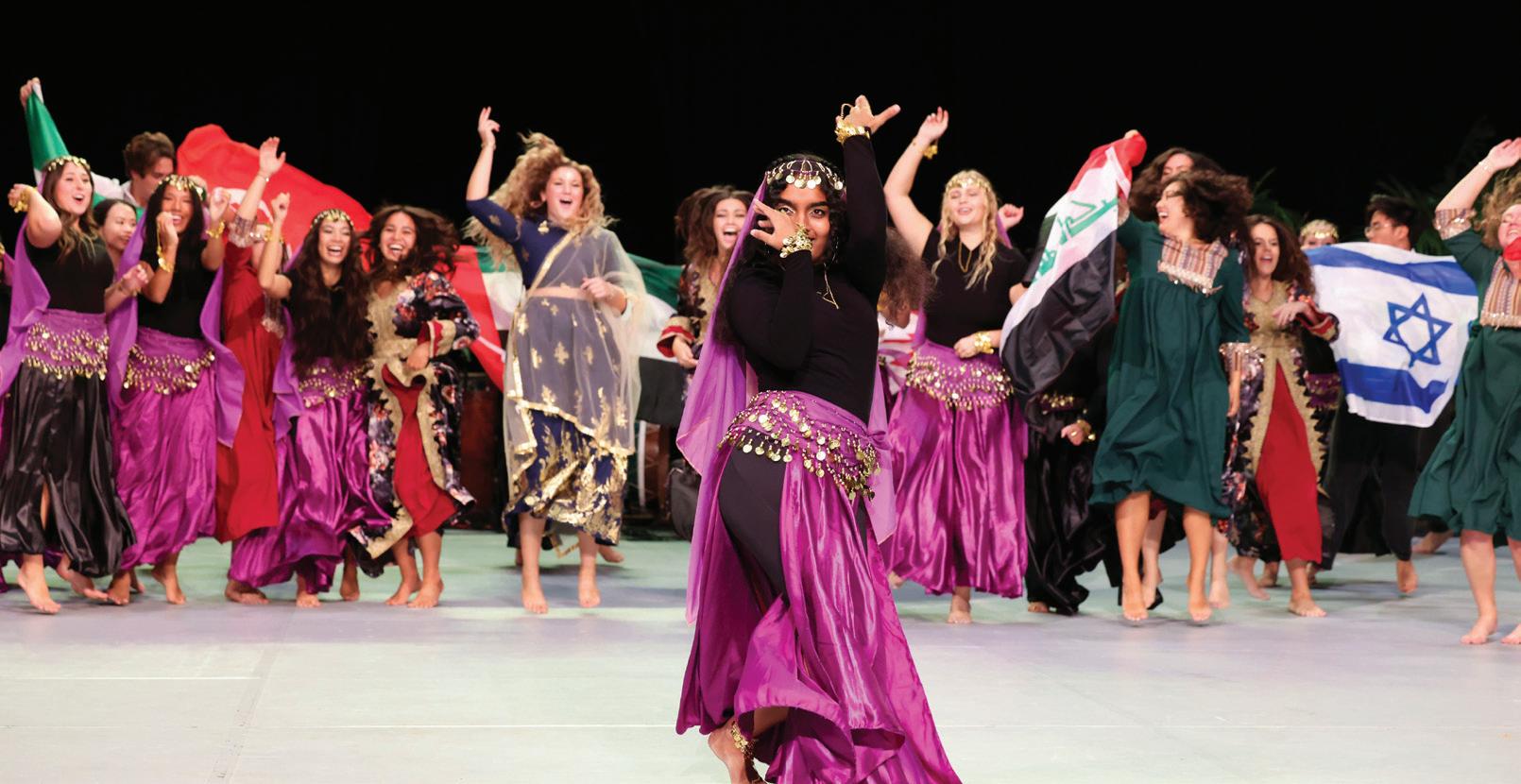


 Performers in the Golden Mecca Club represent Iran, Egypt and Afghanistan through different styles of clothing, music and dance.
Photos by Ke Alaka’i photographers. Graphics by Yichi Lu.
Performers in the Golden Mecca Club represent Iran, Egypt and Afghanistan through different styles of clothing, music and dance.
Photos by Ke Alaka’i photographers. Graphics by Yichi Lu.
Papua New Guinea
Dancing to the beat of the drum
BY EMELIA MIKE


The heartbeat of Papua New Guinea’s Culture Night performance was in the drums, said Warren Miva, the PNG Club’s choreographer and a senior majoring in information technology from PNG. Miva said, “The previous year, we mostly used audio recordings. For this year, we aimed to use just traditional instruments.” The club used drums for the beats and rattles made from shells for the sounds, he said. The fast-paced performance was a celebratory dance about fishing, he said, because “back then, our people lived on fishing.”
Macy Wasi, a sophomore majoring in social work from PNG, said, “The main reason I joined Culture Night is to represent Papua New Guinea because it is my pride





and joy.” Wasi said her country has a variety of traditions and cultures. “Back home,” she explained, “my way of dancing is different from the other provinces. Even our traditional outfits are slightly different in terms of design and decorations.”
The dancers wore white, red, yellow, blue, green and black body paint on their faces, chests and ankles. Bunches of bright green leaves were tied around the performers’ upper arms and the girls swished white poms in their hands back and forth to the beat of the drums. The last dance was characterized by its side-to-side motions and distinct steps, arm movements and head tilts.
The PNG Club President Robert Kilori, said, “Our country is one of the islands in Melanesia and we aim to enlighten [others about] our culture by sharing it with everyone.” Kilori said the club had about 35 students performing this year. He said he hopes each of them was proud of their heritage while performing. •
Dressed in layers of woven material, accessories and skirts, the Papua New Guinea Club dances to the beat of live drumming.
Photos by Ke Alaka’i photographers.
Graphics by Yichi Lu.
SPECIAL ISSUE 43
Mongolia
Imitating a nomadic lifestyle
BY EMMIE SIEBERT
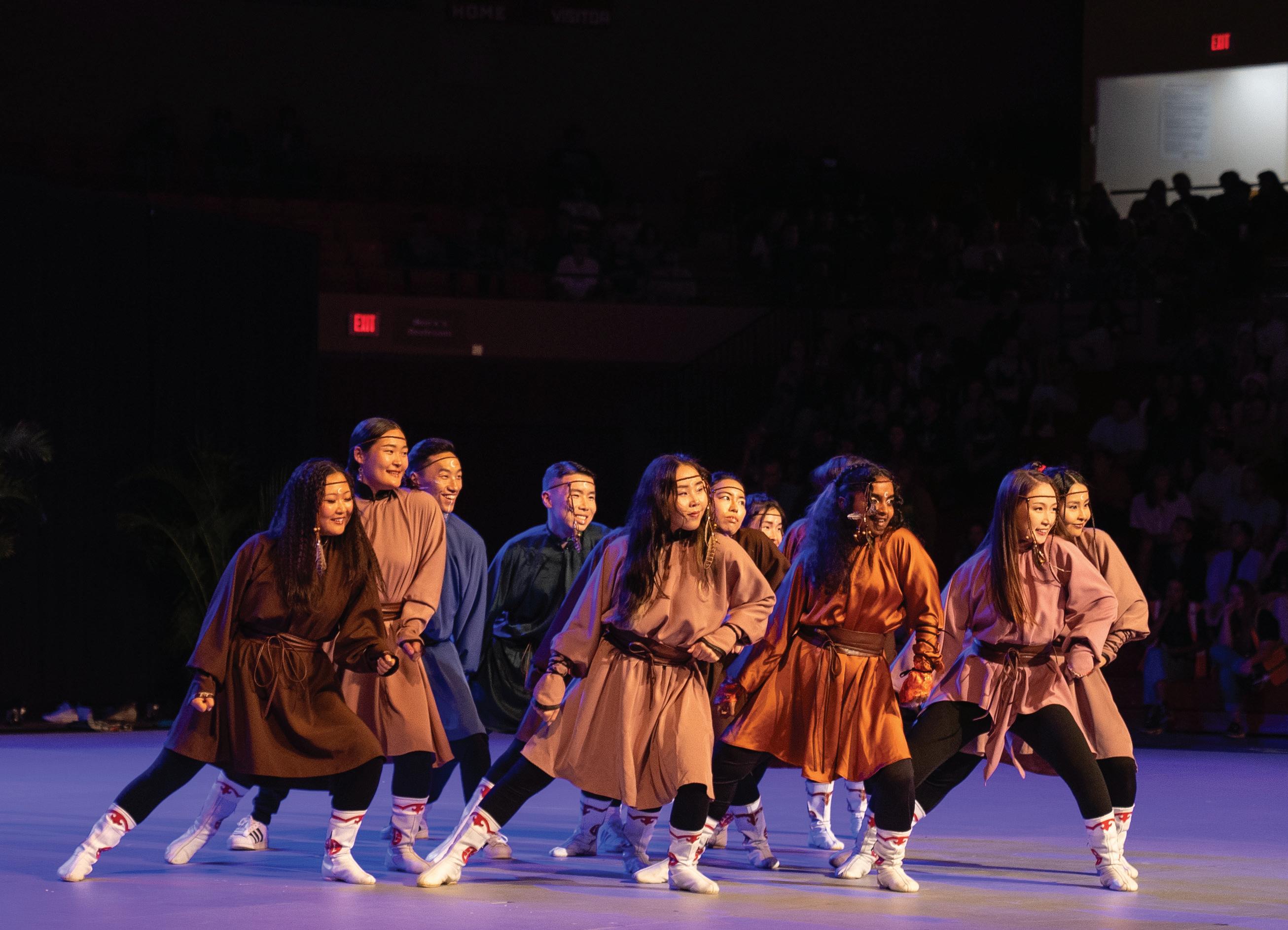
Shadows moved quickly across the stage and assembled in a sharp V-formation as the audience screamed and cheered in anticipation for the Mongolia Club’s first dance. A spotlight flashed on as each dancer’s arms raised above their head, their hands making a triangle. The crowd’s volume grew as the music began, and the dancers slowly brought down their arms, matching the tempo of the song. A sudden shift in the music with the tempo doubling in speed coincided with the dancers moving their shoulders up and down, imitating horseback riding.
Tsetsegdari Enkhbold, the choreographer for the Mongolia Club, shared, “Traditional Mongolian dance reflects a nomadic lifestyle.” Historically, living nomadically was the Mongolian way of life, she said, and some still live that way today.
Men typically have soldier-like moments during the dances, said Enkhbold, a sophomore from Mongolia majoring in business management, while the women “have
the hidden ability to do flexible things.” She said the flexibility in the dances imitates nature and shows that women and nature go together. Elle Shek, a club member from Hong Kong and senior majoring in TESOL, said some of their dance moves resemble riding a horse.
Members of the Mongolia Club will be wearing clothing called a “deel” when they dance, said the Mongolia Club President Maralzaya Buyanbadrakh. She said Mongolians have been wearing the deel for thousands of years as their traditional clothing. Some continue to wear it today and everyone wears it for celebrations, said Buyanbadrakh, a business management senior from Mongolia.
Shek and her husband, Dallin McKinney, who is a senior majoring in music from California, are moving to Mongolia this May to teach English. Shek said, “Music and dance is a big part of their culture. If we try to be part of them, we will be more prepared for the trip.” McKinney explained they feel it is hard to help someone if you don’t know them. •

44 KE ALAKA‘I




 The Mongolia Club dancer’s movements mimic nature and the act of riding a horse during their performance. Photos by Ke Alaka’i photographers. Graphics by Sugarmaa Bataa (Kendra).
The Mongolia Club dancer’s movements mimic nature and the act of riding a horse during their performance. Photos by Ke Alaka’i photographers. Graphics by Sugarmaa Bataa (Kendra).
China

Showcasing intersecting influences
BY MYCO MARCAIDA
With the dancers united in wearing red clothing, the China Club members waved their flag as they joined together in a final performance inspired by a trending TikTok dance.
Yuxian Gu, the vice president of the China Club and a senior majoring in computer science from China, said the club integrated trendy music, dances and clothing with traditional Chinese elements in their Culture Night showcase. “The performance demonstrates how foreign cultures are embraced while maintaining Chinese cultural identity,” Gu explained.
Gu said the performance was more energetic and less delicate than traditional Chinese dance movements. The first costume emulated what people wear today in the 21st century, during which the performers wore black dresses accompanied by orange fans. In contrast, the second costume mimicked what women wore in the early 20th century and the third costume was closer to women’s clothing in the Tang dynasty, which spanned the years of 618 to 907, but with a modern design, Gu said. The performers in the second dance used smaller fans with pink and orange hues and wore white dresses. Gu explained the club chose different costumes to show how their culture has changed throughout the years from both local and Western influences.
Rina Hirano, a junior majoring in business management from Japan, said dancing has always been a part of her life. “As one of the choreographers this year, I am determined to develop my leadership skills and dance skills at the same time,” she said. Hirano said her experience in hip hop and K-pop dances helped with how she choreographed the Chinese pop, or C-pop, dance. •
46 KE ALAKA‘I
Members of the China Club take to the stage in outfits with elements of red to portray three different generations of Chinese culture. Photos by Ke Alaka’i photographers. Graphics by Yichi Lu.
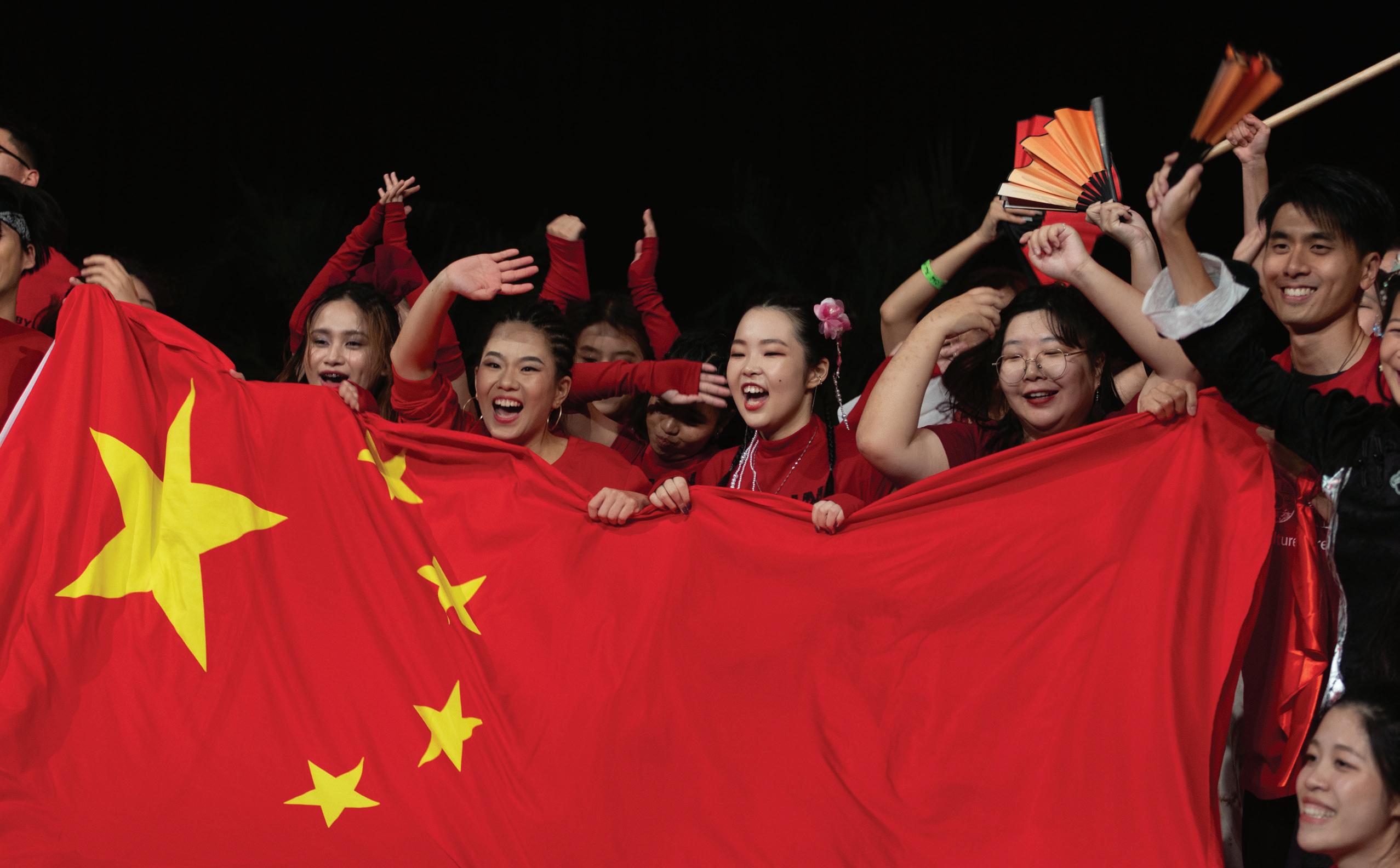







India
A tale of three dances
BY LINDA LAULU
In India, dance is a way to celebrate and pass on traditions, ancient stories and cultural values, said the India Club members. Keerthana Kalyani, the choreographer for the India Club and a freshman from India majoring in biology, said this year, the club showcased the classic Indian dance forms of the bharatanatyam, the bhangra and the garba.
She explained, “Bharatanatyam is not just a dance form but also a spiritual practice with hand movements and mudras, or gestures that symbolize different aspects of Indian culture.” The bhangra and garba dances were originally performed to celebrate the harvest seasons, emphasizing community, joy and the spirit of celebration, she shared.
The India Club President Saravanan Sekar said the club focused on India’s diverse
clothing and dance styles for this year’s Culture Night. Sekar, a junior majoring in health and human sciences from India, shared, “Our club members were thrilled about the costumes and performances, just like I was,” he said.
Describing the attire for each dance form, Kalyani explained, “Bharatanatyam dancers wore regional attire such as sarees along with jewelry and other accessories to enhance the storytelling.” The stage sparkled with the club members’ vibrant costumes as they moved fluidly and swayed side to side, and the cheers of spectators filled the air, echoing from one end of the venue to the other.
For the bhangra, Kalyani said the men wore vibrant kurtas lungis, which are long shirts and vests adorned with embroidered

patterns. The women wore colorful salwar kameez, which is a tunic top and loose-fitting pants, or lehenga, long skirts with traditional jewelry, she said.
Kalyani further explained, “Female garba costumes include the chaniya choli, a traditional three-piece attire adorned with mirror-work embroidery while men wear kediyas, or traditional tops, and kafni pajamas.”
Leneah Olsingch, an exercise and sports science senior from California, shared, “There are so many different styles within Indian culture and learning about these different styles has helped me better understand my peers [from India].” Being a part of the club helped her realize we are all children of God no matter where we are from, she said. •




 The India Club performers smile while dancing the bharatanatyam, the bhangra and the garba for a cheering audience.
Photos by Ke Alaka’i photographers.. Graphics by Sugarmaa Bataa (Kendra).
The India Club performers smile while dancing the bharatanatyam, the bhangra and the garba for a cheering audience.
Photos by Ke Alaka’i photographers.. Graphics by Sugarmaa Bataa (Kendra).
Tahiti
Dancing through generations
BY KARL ALDRE MARQUEZ


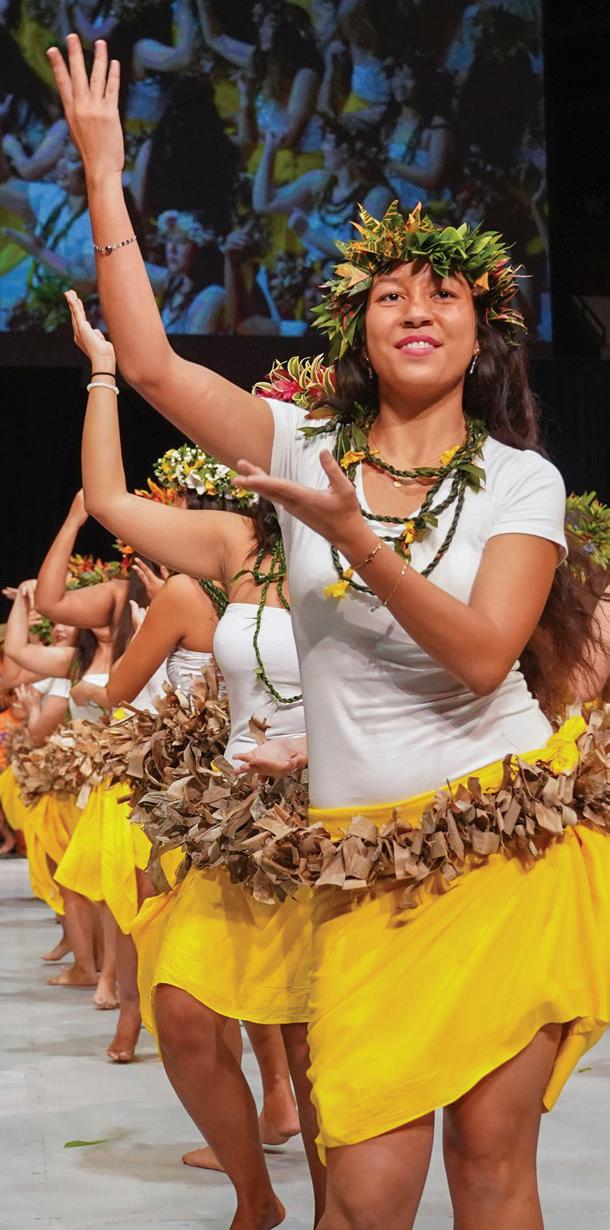


Blending the dances of different generations by combining old styles with new styles and classic music with trendy music was the theme for the Tahiti Club’s Culture Night performance, said the Tahiti Club President Haoariki Harehoe, a junior from Tahiti majoring in mathematics.
He said their dances were composed of steps known around the island. The men did the pā’oti, a scissor dance, while the women did the tamau, a side-to-side hip movement, he explained.
Dressed in matching orange T-shirts with “Tahiti” written in blue and wearing sunglasses, the drummers banged on their drums repeatedly in a thumping, fast-paced beat. The women and men danced in unison, matching their hand and leg movements to the drum beats as the audience cheered for them.


The performers smiled at the crowd and the audience’s applause grew louder as the dancing sped up throughout the performance.
Harehoe said the dominant color of the dancers’ costumes was yellow, symbolizing the sun and the welcoming Tahitian people. He said the women wore traditional dried banana leaves hip bands, flower crowns and white tops. The men wore a yellow pareo, or wraparound, he said, and sacred Tahitian ti leaves on their legs and arms.
Harehoe said he was amazed because people from all over the world who had never heard of Tahiti wanted to participate with them and learn more about their culture through dancing.
Club member Tutehau Hunkin said dancing with the Tahiti Club helped him appreciate the traditional steps that were
passed down from generation to generation. Hunkin, a junior from Utah majoring in marketing, said the steps were complex but fun to do with a big group. The Tahiti Club increased his admiration for his Tahitian roots by showcasing dances that are relevant to them, he shared.
Kurea Hanano, a freshman from Japan studying social work, said she learned through her participation in the club that Tahitian traditional dances are very powerful and spiritual because they were passed down for generations to be shared with others. She said it amazes her how past generations preserved the dances for people to perform them today. •
The Tahiti Club members stand tall with smiles on their faces as they honor Tahitian traditions through song and dance. Photos by Ke Alaka’i photographers Graphics by Sugarmaa Bataa (Kendra).
SPECIAL ISSUE 51
Philippines
Embracing the culture of home
BY LINDA LAULU


The Filipino Club represented the country’s three major island groups of Luzon, Visayas and Mindanao during its performance, said Filipino Club Choreographer Christian Bandujo.
Bandujo, a junior from the Philippines studying health and human sciences, said, “We wanted to show the world how colorful, diverse and beautiful our home country is in respect to [our] culture.” He explained the performance was composed of a selection of cultural elements from each island, such as the pandanggo sa ilaw dance from Luzon, elements of the Tuna Festival from Mindanao and an original pop music dance from Visayas.
During the pandanggo sa ilaw, the women wore yellow dresses and the men wore green tops and black slacks. They danced in pairs while the women swayed from left to right holding candles in their



hands. Bandujo discussed the meaning of the costumes, “We used a touch of yellow in the pandanggo sa ilaw since it was a courtship dance where we wanted to show the lady’s elegance and the gentlemen’s chivalry.”
In the second dance, club members wore blue patterned jumpsuits with green and orange festive headpieces. Dancers held props symbolizing various aspects of island life, transitioning easily from land to sea. The blue costumes in this dance were meant to show the club’s appreciation for their aquatic resources, Bandujo said. In the third part of the performance, three club members sang while the others danced with smiles on their faces.
The Filipino Club President Hanna Pearl Tumon, a junior majoring in social work from the Philippines, said the club had difficulties finding affordable costumes for their performance. “However, through prayers and connections, the club eventually found a supplier from the Philippines,” she shared. The supplier had also prepared the outfits for the Tabernacle Choir’s World Tour stop in the Philippines, Tumon said.
Dave Noynay, a freshman from the Philippines majoring in biology, said, “[Culture Night] reminded me of my roots and how wonderful our culture is, and the world deserves to see it.” During Culture Night, he said he felt the spirit of bayanihan, which represents unity, helping others without expecting rewards and achieving a certain goal. “Even though we are far from home, we are still carrying that spirit that is embedded in our character,” he said. •
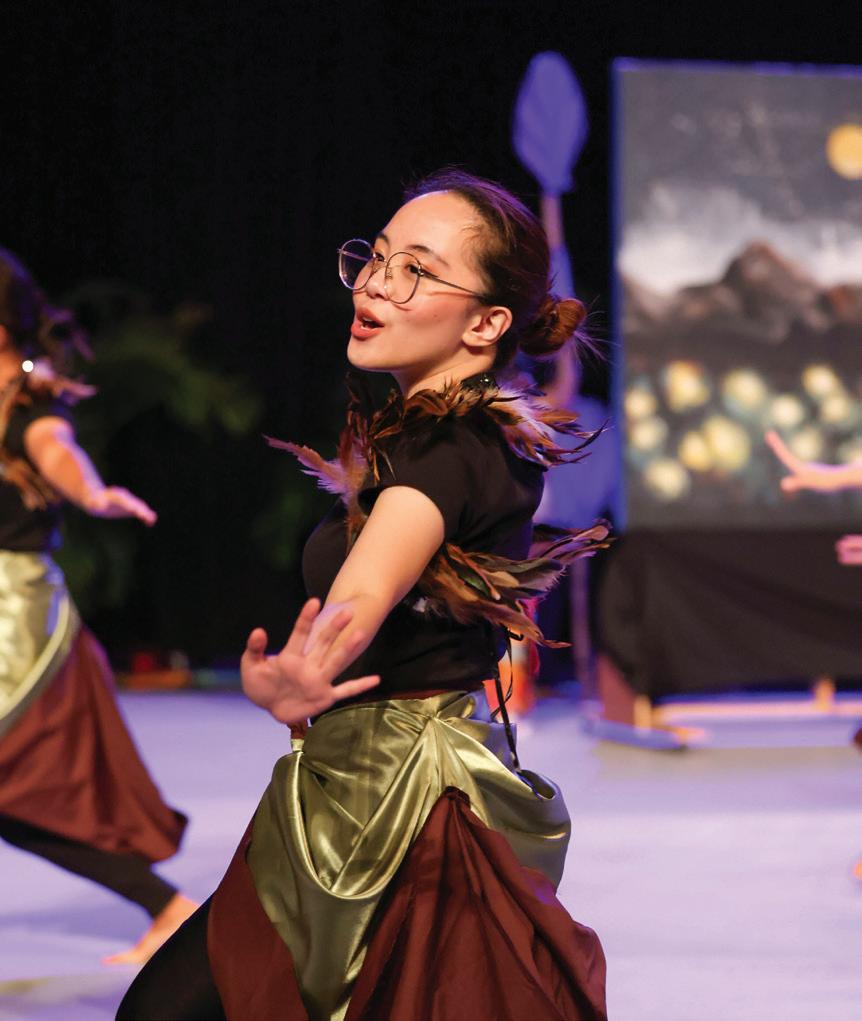

Dancers in the Filipino Club represent three major island groups through a traditional folk dance, a performance honoring the Tuna Festival, and a original pop music dance.
Photos by Ke Alaka’i photographers..
Graphics by Sugarmaa Bataa (Kendra).
SPECIAL ISSUE 53
Fiji
Vucu and meke
BY EMMIE SIEBERT
Kelemedi Dubudubu said he has learned more about storytelling through “vucu,” which is a Fijian war preparation dance similar to the Maori haka and was the Fiji Club’s first dance at Culture Night. Dubudubu, a sophomore majoring in social work from Fiji, said both men and women participate in the vucu.
The Fiji Club was the final performance of Culture Night, and they took the stage to with supportive cheering from the crowd. The mass of the Fiji Club members sat shoulder to shoulder in a clustered circle, with the men on the outside and women on the inside. Starting in silence, the club began to sing a Fijian song in a two-part harmony with full, chest voices. Once the song ended, the women got up and ran off the stage while the men, with smiles on their faces, jumped up and down in preparation for the vucu. Later the women joined the men with sharp movements and faces beaming as they danced their story.
“Meke” is the Fijian word for dance, says the Polynesian Cultural Center’s website. The meke is unlike other Polynesian traditional dances like the Tahitian dance or Hawaiian hula, according to Kelera Tuinakauvadra, a junior majoring in psychology from Florida with Fijian heritage.
“There is no hip or foot movement,” she said, but “I like how expressive it is.” She said meke is an expansive dance that uses your arms.
Dubudubu said he was impressed by the respect the club members had for the leaders during Culture Night practices. “Even though we are all students, when we come to Culture Night practice…whatever they say, we follow,” said Dubudubu. •
The Fiji Club’s performers are all smiles as they come together for the final performance of Culture Night.
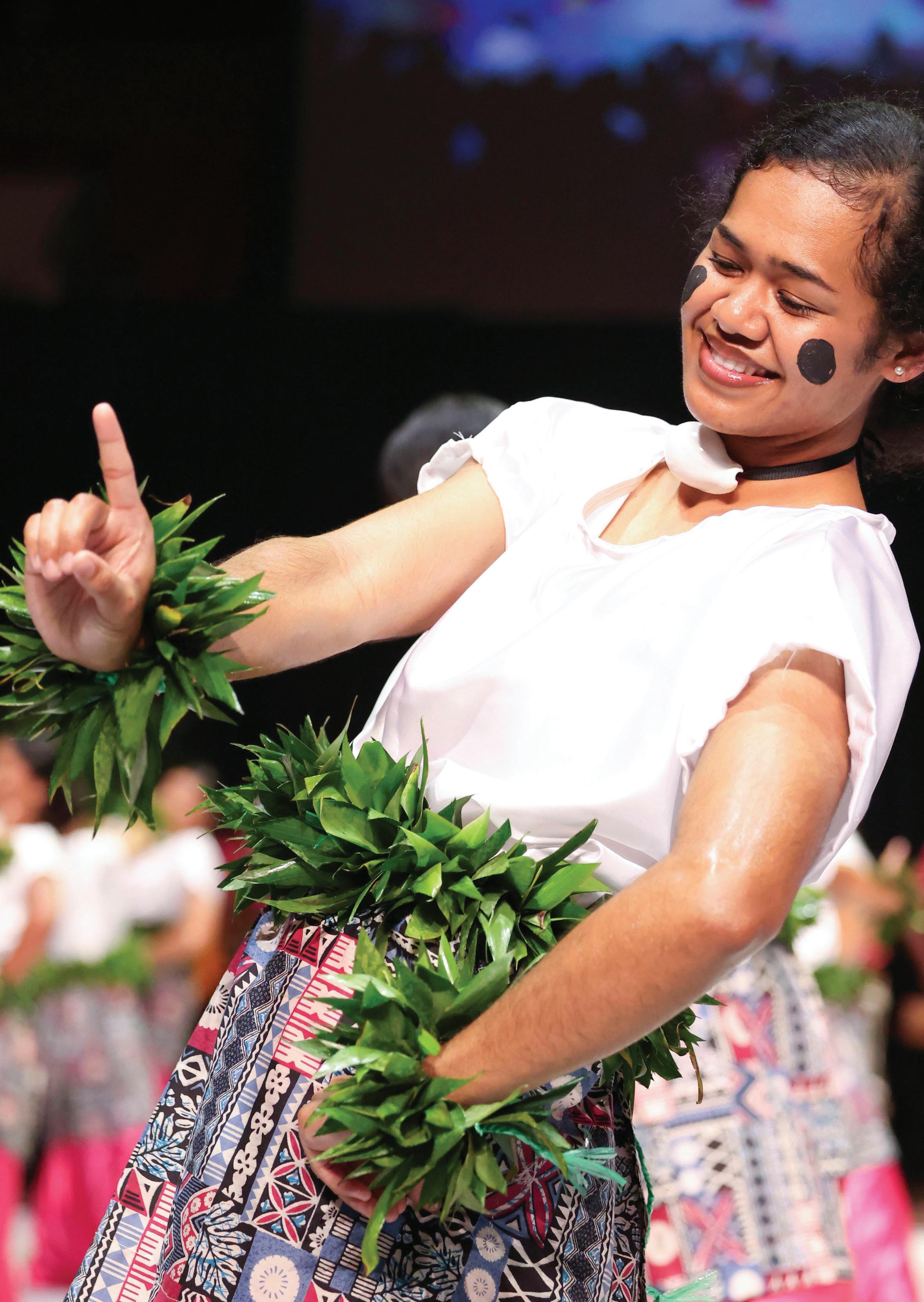

54 KE ALAKA‘I
Photos by Ke Alaka’i photographers.
Graphics by Sugarmaa Bataa (Kendra).







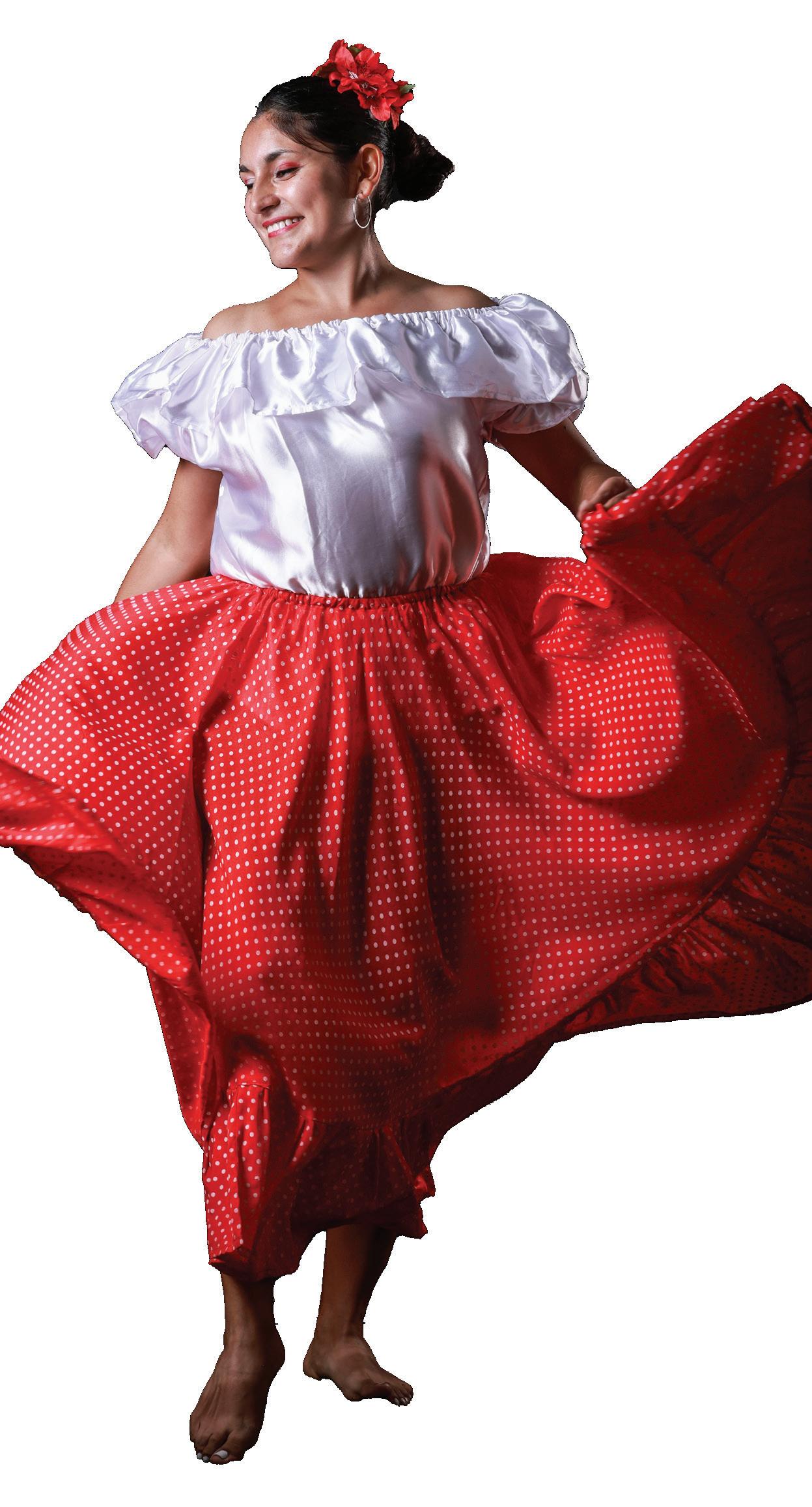





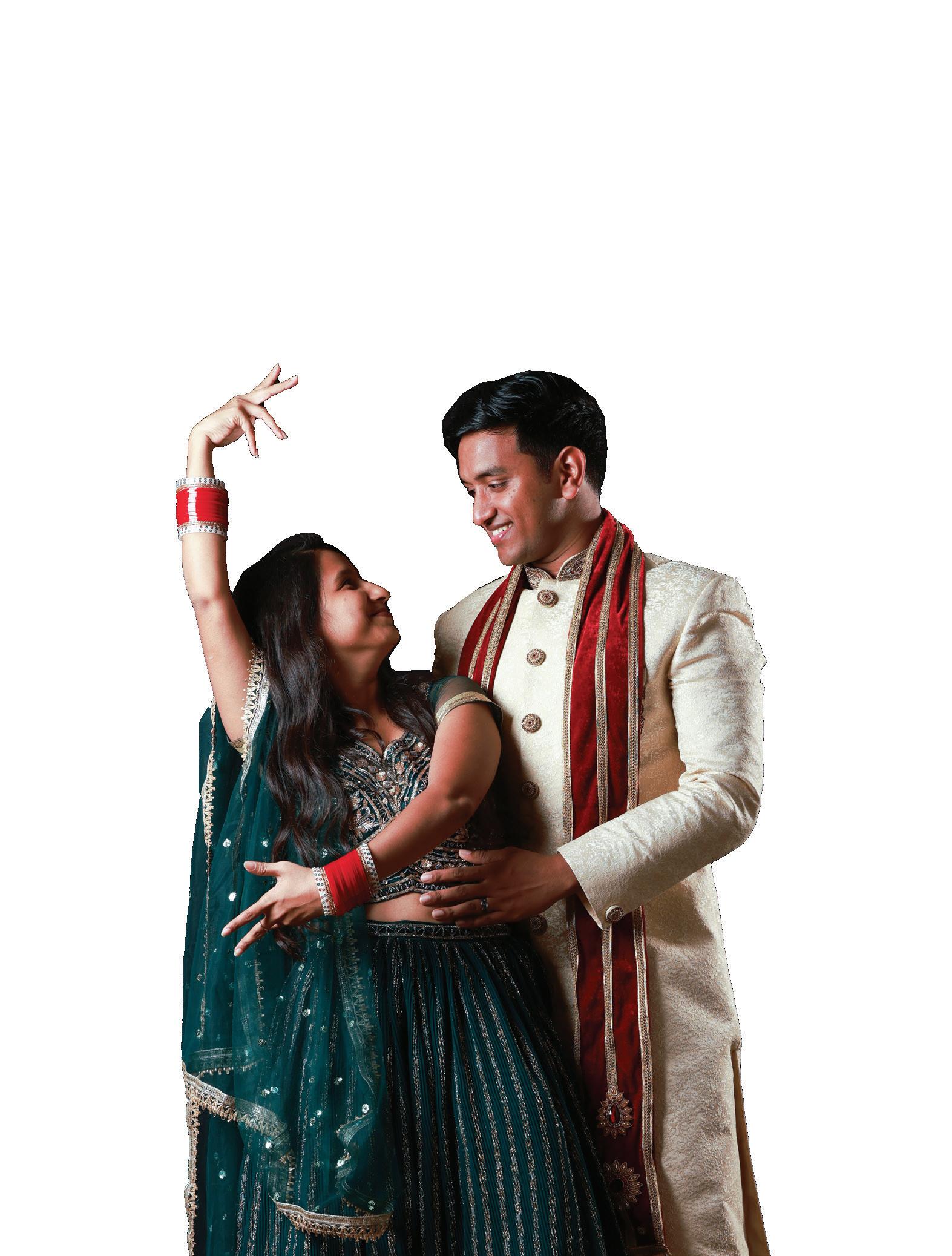


































































































































 Through
the Cook Islands.
Photos by Ke Alaka’i photographers.
Graphics by Sugarmaa Bataa (Kendra).
Through
the Cook Islands.
Photos by Ke Alaka’i photographers.
Graphics by Sugarmaa Bataa (Kendra).






















 The Latin America Club represents various Latin America countries through colorful costumes, dances and songs. Photos by Ke Alaka’i photographers. Graphics by Yichi Lu.
The Latin America Club represents various Latin America countries through colorful costumes, dances and songs. Photos by Ke Alaka’i photographers. Graphics by Yichi Lu.































 Performers in the Golden Mecca Club represent Iran, Egypt and Afghanistan through different styles of clothing, music and dance.
Photos by Ke Alaka’i photographers. Graphics by Yichi Lu.
Performers in the Golden Mecca Club represent Iran, Egypt and Afghanistan through different styles of clothing, music and dance.
Photos by Ke Alaka’i photographers. Graphics by Yichi Lu.













 The Mongolia Club dancer’s movements mimic nature and the act of riding a horse during their performance. Photos by Ke Alaka’i photographers. Graphics by Sugarmaa Bataa (Kendra).
The Mongolia Club dancer’s movements mimic nature and the act of riding a horse during their performance. Photos by Ke Alaka’i photographers. Graphics by Sugarmaa Bataa (Kendra).














 The India Club performers smile while dancing the bharatanatyam, the bhangra and the garba for a cheering audience.
Photos by Ke Alaka’i photographers.. Graphics by Sugarmaa Bataa (Kendra).
The India Club performers smile while dancing the bharatanatyam, the bhangra and the garba for a cheering audience.
Photos by Ke Alaka’i photographers.. Graphics by Sugarmaa Bataa (Kendra).






























